-
Title
-
The Marksman Magazine
-
Issue Date
-
Volume I (No. 2) August 1939
-
Year
-
1939
-
Language
-
English
-
Rights
-

-
extracted text
-
~~A~NE D!!DaTOro~!!l!!T~ PubUshed Monthly by The National Rifle & Pistol Asso·ciation P. 0. Box 883, Jlfonila Subscription Rates: 1-Year P2.-; 6 illonths Pl.50; Single Copy, P0.20. VOL. I MANILA, AUGUST, 1939 NO. 2 l:IUIT()l214L CARRYING FIREARMS We understand that the Chief of the Philippine Constabulary has· requested from Malacafian the issuance of an executive order, under Section 905 of the Revised Administrative Code, prohibiting the .carrying of licensed firearms in all public places, except by persons who· have an immediate need. for a firearm in connection with the discharge. of their lawful occupation. We wish to express our sympathy for the motive prompting such a request, but we believe such an executive order would be too sweeping ·as to cause an injustice to licensed firearm holders throughout the Philippines. To give a few exampl~s of how such order would prove impracticable : A businessman from the province comes to Manila, carrying a large sum of money, and therefore armed with a licensed revolver. H~ finishes his transaction, and in the evening wants to go a movie or dance. hall-what should he do with his gun? Leave it in his hotel or lodging house room (where the chances a.re that it wm be stolen) or. take it along with him? The answer is obvious. So long as conditions of peace and order in many of our municipalities, especially in the City of Manila, are unsatisfactory to the extent that robberies are rampant, such an Our magazine cover for this issue shows Col. Antonio Torr'es, chief of police, pinning the gold medal on Patrolman Acosta of the Traffic Division, winner of the recent Manila Police Pistol Championship sponsored by the NRPA. The crack Traffic Division of Capt. Nievera won, hands down, the Farmacia Central Trophy for this year. 2 THE MARKSMAN August, 1939 executive order would entail an injustice. Again, a licensed firearm holder goes out on a spin in his automobile, and meets an accident .with a c.alesa .. The cochero, who is notoriously insolent as a clas.s, takes out an iron bar or a balisong during the ensuing argument. Isn't that the time for the car driver to have a firearm,, the display of which is always sufficient to make the cochero behave? Yet, under the proposed executive order, the car driver with a licensed firearm will not be allowed to carry his gun. We finaly believe that the prohibition of carrying duly licensed firearm is not the cure to this exhibitionistic tendency among our people. Does not a child react similar]y when he has a toy which is rare and the envy of his playmates? To the Filipino, a revolver is a prized object, whose possession places him a notch higher than the rest of his countrymen. Why? Because the right to possess firearms belongs only to ~l. limited few, to a very small percent!lge of the population. There are only two permanent solutions to curbing the display of licensed firearms; either confiscate all existing licensed firearms, and issue new licenses on a very strict basis ; or liberalize the issuing of firearms so that it may become commonplace to our- people. Naturally, we favor the latter procedure, for we are convinced tha;t:s_irice _our plans for Nationa~ Defense are based on a citizen army, our peopl_e niust- I?e trained as soon as possible in the intelligent ~nd proper use· of a firearm. And the sooner the government realizes this- fundamental axiom, the sooner we need not fear foreign aggression in the event of independence. NRPA * * * * REGULAR MEl\IBERSHIPp. I. CITIZENS Entrance Fee -------------- Pl0.00 Monthly Dues ______________ 1.00 LIFE MEMBERSHIP A lump sum of ____ ..:. _______ P50.00 Associate Member-Members of P.A., P.C. & Police No Entrance Fee-Monthly Dues, Pl.00 Sustaining Member For Foreigner only Entrance Fee ----- -------- Pl0.00 Monthly Dues ---- -------- 1.00 For Particulars write to NATIONAL RIFLE & PISTOL ASSOCIATION P.. 0. Box 883, Manila Clip application blank on page 52
August, 1939 THE MARKSMAN 3 Philippines' Outstanding Pistolman This distinction belongs only to Mr. Felix Cor - tes who holds the record of 524 points made in actual competition in February this year during the J. Araneta Trophy Shoots. He is an all.. around shot, having won. several prizes in rifle corrqX!ti ti ons. In trap and skeet shooting Mr. Cortes is deadly to reckon with. l\iir. Cortes and his family left for· a vacation to the United States last June 5. On the eve of his departure the members of the board of directors and other committees of the NRP A gave him a Bon-Voyage party at the Marco -Polo Hotel. On this occasio~, .. , -he. . irif ormed his colleagues that his trip abroad was not merely for pleasure as he also intended to parti.= cipate in pistol events, particularly in Camp Perry and in such occasions when he shall be able to represent the FELIX CORTES NRP A. While in the States, Mr. Cortes will also get in touch with some rifle and pistol experts to further his knowledge in target shooting and learn new things which will be of value to the association. He will make a study of the types of guns and ammunition that are proper for target shooting. A sight of a target range fascinates Mr. Cortes more than anything· else. Next to his wife and kid, he loves his guns and has a way of almost "spoiling" them by taking too good a care of them. Mr. Cortes is a civil Continued on page 35 August, 1939 THE MARKSMAN 35 THE SHOOTING MARI NE IN ACTION That's Capt. Graciano Castafieda, left, who has to his credit several pr~ze winning medals in the annual shooting events of the N. R. P: A. Res.erve Officer in the Philippine Army, and Second Officer of the Government Cutter "Arayat", Capt. Castaneda is also a rifle and pistol expert. The N. R. P. A. proudly claims him among its successful members. He placed second in the Gil Montilla Individual Pistol Match Center Fire in March 1939, and topped a b]g field of 22 pistolmen in the last Club Pisto'~ ,Handicap with gold medals at stake. That Capt. Castaneda has a bright future in pistol shooting can no longer be gainsaid. He is also handy with the rifle both in low and high power. Here he is shown with his Springfield with which he has brought them down and fast. (Capt. Graciano Castaneda, P .A.R.) - * * * * PHILIPPINES' OUTSTANDING PISTOLMAN Continued from page 3 engineer by profession, but you will find more gun books and literature .in his library. He is a good gunsmith and mechanic. He has a gun· shop in his house in New Manila, which is considered the best equipped of its kinrl here. Like her hushand, Mrs. Cortes (nee Amparo Joven) is a gun enthusiast. When not busy with her household work, she loves to go target shooting. She is handy with any pistol from .22 to .45 cal. Mrs. Cortes is a champion in her own right as she has been the Lady Champion Shoot rl.n the Philippines for the last three years. In the last open .45 cal. pistol event, .she placed fourth, but defeated a strong- field of 45 good pistolmen. Mr. Cortes won this event.-A. N. FLORESCA.
4 THE MARKSMAN August, 193~ LITTLE THINGS By ALFREDO E~ LITIATCO (Editoi"s Note: We came· across this i~em in the July 27, 1939 issue of the GRAPHIC by the well-known columnist of that publication. We believ~ that the re· actions of a layman like Mr. Litiatco on the subject of the proposed prohibition to carry guns are so interesting that we are he.reby reprinting them without further comment.) SOME time ago, a planter shot a tenant. To ask a rhetorical question: Was there much of a fuss made about it? Apparently, no one even thought of disarming the gun-toting planter. Subsequently, that same planter got involved in the shooting of two millionaires. This time, the authorities-that is, the official represcnta ... tives oi the law under which all men are theoretica!ly ellual-becamf: so anxious to Do · Something that, among other things, they decided to re ... lleve all civilian (though licensed) gun-toters of their weapons. It seems you may not now cariy a gun to places where, or on occasions· when, you might possibly be tempted to use it. Now, if they must resort to that, why didn't they ihink of doing. so earlier? When, for example, that tenant got shot. Must a millionaire be~ome a target before officials in a democracy awake to the value of human life and the menace of gun-toters? Let us grant that those millionaires were, as some say, good men. Wl right: it's really too bad they were killed; the world has need of aH its good men. But that's just the point, see? It 3Jiould always be too bad that a good man should be killed-whether he has fifty millions or makes only fifty centavos a day. A tenant, as much as· a miUionaire, has a stomach to fill, a family support, a heart that can yearn, hands that can work. So you may weH ask: What has a millionaire got that a tenant hasn't? - Well, now. I'll tell you. A tenant, unlike a millionaire, hasn't the means to travel around the world in comfort and at will, to mainfai.n a fleet of expensive cars, to make instant business successes of his sons and and social successes of his daughters, to buy anything from mistres.ses to high. government positions, to consult a specialist in Vienna and patronize a dance master in New York, to be always sure of three square meals a day and six rounds of drinks each night-in short, to have the feeling, when he comes to die, that life hasn't been so bad. . . . And anyway, why have a gun unless there is a possibility of using it? Are the authorities under the impression that one pays good Continued on page 25 August, 1939 THE MARKSMAN 25 Had the presidente used the ejector instead of merely knocking the cylinder, he would be alive today. And had the Spaniard inspected the gun before snapping the trigger, the tragedy would not have happened. As ·it was, a loaded shell got stuck in the cylinder and the presidente is now pushing lilies up underneath six feet of ground. --x-Americans are practical jokers, but sometimes foolish! A shiftless middle age fellow, who was on government relief in the city, got tried of his environment and decided to visit his brother. His younger brother was a police officer in a small town. The shiftless one hitch-liked. On the way he thought. of pulling a neat joke on his kin. Arriving at hi,s destination late at night, he covered his face vdth a handkerchief and sneaked into the home of his brother. Unknown to him the small town copper was alert in his bed. He had heard a noise. The shiftless fellow entered his brother's room and ordered him to get up. A hand trust in his overcoat pocket gave the impression that a gun covered the man in the bed. There was a quick movement in the bed. Then a shot. When the police came the shiftless one was able to gasp, "It ·;.ras· all a joke" and then expired. The officer was exonerated. A nifty joke, eh? LITTLE THING Continued from page 4 * * * * money for a revolver merely to be another Carlos Quirino or Eva Estrada, or to satisfy an exhjbitionistic urge? I, for one, would not procure a gun except to shoot all the pests I have long wanted to rid this world of. There are many such pests, you know. There's the guy who sits in front of you in the theatre, callously smoking a gigantic cigar in spite of all the girls choking jn, his· vicinity. And the fellow standing over you in the tram who proceeds to spray your new white woolen suit with vile.smelting ash. Not to mention the bully who flings loud, sarcastic, uncalled-for remarks at waiters, conductors, and other wretches who are restrained by the idiotic doctrine that the customer is always brigt. But I'd better· cut short the enumeration. There isn't enough space -and I might end up by proposing my own suicide!
August, 1939 THE MARKSMAN 5 An Episode In Duck Hunting It Took A Woman To Provoke This One -----@----There was a special provocation for this particular hunt, as will be explained later. To one of limited means a really successful duck hunt in Laguna Lake appears well nigh impossible. 'Of the various ways used in hunting ducks in Laguna Lake the following are the most common: ,shooting over decoys, shooting from bancas and from motorboats and sneaking to. the birds by wading. To get the day's bag of 35 ducks or even more, motorboats have to be employed. One can get quicker to the flock and can cover a much larger area. But the present law prohibits the use of motorboats and a bag exceeding- 35 ducks a day. This pro~1ibition however is virtually a dead law. Motorboats have been used during the last duck season. And what more, the violator is a commercial hunter. The most enjoyable method is perhaps sb~ting over wooden decoys. One is relaxed all the time, and there is always:fun fooling the birds. · As a rule, however, the bag is none too attractiVe. But one who is a game hog should be satisfied with a half dozen big fat Chinese black ducks. Shooting from bancas is the usual method employed by the natives. It is cheaper. But shooting ~from bancas is often dangerous as the bancas are riggerless and the water in Laguna Lake is very fickle. Then too, when trouble comes and one is out in the middle of the Lake, it takes very long to reach the safety· of the shores. The writer was out one day accompanying a Constabulary Officer. .in one of the latter's visits to a dynamite deposit on Talim Island and the big Constabulary I·aunch we were on almost sank when the big waves rose late in the afternoon. The experience of Manoling Earnshaw and his party is good proof of how mean lhe Lake could become without giving any warning a.t all. The writer has an American friend who has developed an .intense fear of the Lake. He went out duck shooting one morning using a banca. He almost never came back. His banca capsized and it was no little trouble afterward' diving for his guns that sunk to the bottom. One may be a good swimmer but his chances of surviYfag are practically nil when he has to swim a mile or two .ashore through rough water. In case the banca capsizes, too, one will likely lose his guns, ammunL 6 THE MARKSMAN August, 1939 tion and all. To the prudent, the writer does not advise shooting ducks in the Lake from a banca, unless the birds are close to shore, and this seldom happens except immediately after a storm when the birds are driven to shore to seek shelter among the reeds. And of course the potentialities of shooting ducks by wading towards them are limited. One does not get a full day's fun from it. This article is the story of my most sucessful duck hunt in Laguna Lake. (I now shift to the first person, singular.) I want to tell it here because it is not only thrilling but also instructive. For the benefit of foreign readers, Laguna Lake is a body o:f_ fresh water, about 346 square miles in area and surrounded by the- provinces of Rizal and Laguna. This Lake :is about 14 Km. from Manila. Ih~ most important outlet is the Pasig River, a very important water highway of the Metropolis. The salt water from Manila Bay does not reach Laguna Lake during high tide. Many streamlets empty into this Lake from the two provinces and during heavy rain a large volume of water flows into this Lake. The water is always fresh and murky. Navigation hem is practically limited to bancas and a few sail boats and the "cascos". Fish life is none too abundant. Commercially the lake is not very attractive. It is deep in some places anrl very shallow in others. There is a constant change in the conditions of the floor of this lake so that a regui~r course for commercial shipping is almm;t impossible. A channel now may be a sand bar tomorrow. But Laguna Lake is the main source of food supplv for domestic ducks-the producer of our famous "balut" eggs. The bottom of the lake jg the breeding ~round of many fo1ms of fresh \vater snails, soft and hard shelled, which are highly relished by domestic as well as wild ducks. Hundreds of families rely on this industry for their livelihood. From the air this Lake is clearly visible. Just when the migratory ducks f1 om China discove:i'.'ed this Lake as a good feeding ground, ho one knows. But as far as I can remember, Laguna Lake has always been the mecca of the migratory black Chinese ducks since I first came and hunted birds in Luzon 14 years ago. From the air too, the wild ducks; can see all along the waters, close to shore, the presence of thousands of domestic ducks, swimming around. To the wild ducks, this indicated good feeding ground. They must have therefore swooped down, doverl, hit bottom and discovered. good chow there. They stayed, stuffed themselves to the limit, and when the call of Home ~ame, they left fully satisfied. When they reached home they must have told their fellc1ws there of their wonderful find, and so every year thereafter they came in increasing number to fe'ed on the snails in the Lake when the migratory season comes._ August, 1939 THE MARKSMAN '1 When I made this particular hunt way back several years agfl, the black Chinese ducks in the Lake numbered by the millions. I actually saw a flock on the water as wide as Taft Avenue and about a kilometer long. When it rose, as I approached, it made a noise like the giant purring of the four motors of the Clipper. Ducks were flying all over me, around me, all the time but beyond gun shot. What a sight and what a day, I thought. Yes, what a day indeed! They are still coming every year during the months from November to February. I don't know whether they come in greater or less number now because after this particular hunt, I never hunted them again. I started this story by saying that this particular duck hunt was especially provoked. It came about in this way: My friend in Navc.tas invited me to hunt ducks in Manila Bay near Bataan. We chartered a launch anJ a banca. When we were close to the ducks we dropped anchor. got on the banca and approached the ducks. We were never able to come within shooting range. The ducks were few and wild. It was a very un ... successful hunt but we had plenty of fun watching the porpoises, ana roasting big squids which we got from a mammoth fish trap that housed~ four families. Reaching home that night, the gfrl I was in love with teased me like h- and called me a "bum hunter". This. got my goat. I swore to "show her". So early Saturday afternoon I motored to Taguig, ordered a mo;. torboat rigged for a duck hunt the following day. A good boat to hunt ducks with .should be of the proper type. Its motor must be silent and able to slow down to 5 miles per hour. The sides, front and rear should be reconstructed so as to permit the placement of water hyacinths anCl sufficiently thick enough to hide the men in the boat. This would reduce somewhat the speed of the boat but it is necessary to fool the ducks. All over the Lake are floating water hyacinths and from a distance such a camouflaged boot looks just like a big hunch of floating hyacinths. When you sight a flock you approach it slowly and as noiselessly as poasfole against the direction of the wfad to prevent the sound of the. motor from being heard by the birds. All people inside must duck while approaching the birds and conversations must be in whispers. \Vith rae there was a motC\rman and a general utility man who also served as guide. Early that Sunday morning, I hired a garage car (taxis were not yet in vogue then), bought a can of gasoline and some motor oil. Breaa, canned .goods and fruits were also purchased, including plenty of drinking water, smokes and. chocolates. The _most important of course were the gun and the ammunition- a .20 ga. ·Winchester pump gun and about 50 8 THE MARKSMAN August, 1939 rounds of No. 6 High Velocity Peters and a box of No. 8 snipe load. A pair of high-powered binoculars completed the equipment. When the sun showed its face, we were already far out in the Lake. There were plenty of ducks in the air and all over the surface of the w~ter. We approached one flock after another but could not get within shooting range. DucH.s flying overhead were also too high for gooJ shooting. The morning was approaching noon hour and it was getting scorchingly hot. There was a little wind however to relieve us now and then. So far we have had no luck after having approached at least twenty flocks, big and small. Then away in the middle of the Lake, right straight from the Binafigonan Cement Plant, I spotted another flock consisting of about 250 birds. Using the binoculars, I could see that the birds were asleep-their hearls were hidden under their wings. They were heavy vtith snails and the light ripples rocked them easily to sleep. No one was flapping its wings or quacking at all. Our position was ideal. I ordered to steer -slowly and right .straight ahead·. The instructions to the motorman were to slow down as much as possible and to watch me closely. As soon as he sees me .stand up, with gun in hand, that means "full speed ahead'' and to keep on until the firing ceased. We ducked low and peered at the birds through the water hvacinths. We were close enough now and the binoculars were discarded. The birds were still as1eep.-I could see that clearly. I was tingling all over. The _safety of my gun was already released. My left hand kept making signs to the motorman to slow d'Own some more as we were getting already too close. I was afraid I could not get within shooting range again. Then one of the birds awoke, shook its head and wondered, with great big eyes, .what was the thing in front of him that looked like a df-lrk solid green. (Every part of the boat must be painted green.) He must have been the leader, for soon he flapped his wings and gave the alarm of quack. quack, quack. In the twinkle of an eye every bird was up and going. The moment of all moments had come at least! The birds were hardly 40 yards away. I straightened up and the boat shot forward at full. speed. Hell broke loose. My gun never worked so perfectly as then and my aim waSI never truer and better. I fired when the birds were only a meter or two above the ·water, and when the .shelUng· was over-you can't believe it-some of the birds were still on the water. They simply didn't know what was happening. They were so dumbfounded they didn't know what to do. My boat literally dove right into them and drove them away. My guide was shouting: "Tingnan mo, natarant~ ang mga pa to." (Look, the clucks are rattled.) I did not believe I could fire more than six rapid shots, and so when I saw that there were some birds left yet I fumbled for the shells. August, 1939 THE MARKSMAN 9 But when I succeeded in reloading they were gone. (There was an extra .16 ga. gun belonging to my guide but he had no shells for it.) Boy 0 boy-What a thrill! After cruising around for about an hour, picking the dead birds that were scattered far and near, 63 big fat Chinese ducks were accounted for. WCth the use of the binoculc.t1·s every dead bird was located. We went after it. hut it refused to be approached, diving as soon as it breathed in a puff of air. The gun and the snipe load now went into play. For about an hour I spent gas and oil and shell on the darn thing and still he kept playing hide-and-seek. When the last of the 25 rounds was gone anq he was still giving me the run-around, T decided to quit. I tipped my hat to him and said: "Well, you beat me, I can no longer afford to spend on you. You refuse to come and die a quick death. All right, rot slowly in that watery grave of yours." And we steered for the distant shore. We pulled out all the water hyacinths and i·elaxed. On the way we ate our lunch and when we were back at the cat, the garage driver was sound asleep. When he woke up he was plain startled to see so many ducks being 'loaded into his rig. After paying the men and leaving them the excess provision, I ordered, "Home, James." When 1 reache·d home I passed by the kitchen, whispered to the cook to fetch the birds from the car and to make no noise about it. Then stealthily, I sauntered into the living room where my girl friend was with other girls and some young men. Among them I looked like a worn-out hobo-sunburnt with 2-day old whiskers on my chin. "What luck?" said one of the young men. "No luck again," I replied with downcast eyes, and they laughed loud. But a more intelligent guy noticed my ,khaki pants and white canvas shoes all smeard with blood. "No luck; ha? What's the blood about?", pointing at the red patches. ·"Oh, old stains from former hunts," I tried to explain. My girl friend' just ran into the kitchen and gave a yell. Why, the whole kitchen floor was simply littered with ducks! Everybody ran out, exclaimed in surprises and showered me with praises. I just smiled modestly. My girl's heart was touched: "Please d'On't shoot ducks again. I pity them all." "I just wanted to prove to you that I am not a bum hunter." I 8aid, Total damage that day: P50.00 including all. Was it worthwhile? You . bet .. But it was in them good ole days when "to miss was mystery and to hit was history."-ERNESTO J. CARABALLO.
10 THE MARKSMAN August, 1939 Seven Reasons Why You Should Join The National Rifle & Pistol Association 1. As member of the NRPA you save reasonable amount from an_ n\lal license fees for every firearm you hold, and you do not need to file a bond required by the authorities. 2. Membership in the NRPA, a national gun club duly accredited by the Phiilippine Army and the Constabulary, will facilitate your obtaining firearms for target use only. 3. You get a free subscription to Th~ Marksman, a magazine dedicated to outdoor sports. 4. Ample range facilities: you may shoot in any of dozen shooting clubs affiliated with the NRA Association. If you are in Manila, the club has two ranges: in Santolan, near Camp Mul"J)hy; and on Pureza Sf.re8t, Santa Mesa, near the National Development Company premises. An experienced instructor is always at hand to help you. 5. More than a score of rifle and pistol matche&.·.are held every year, with valuable trophies and medals given away-for ·beginners as well as ~xperts. Since the NRPA is affiliated with the Philippine Amateur Ath~. Jetic Federation, its open championships are considered national in scope. 6. The NRP A protects the interests of firearm holders by eampaj gn_ fog for more liberal rules in the granting of firearms to qualified citiz~ns, opposing legislation prejudii:cial to the interests of shooters, and cooperab ing fully with plans for National Defense. 7. As member of the NRP A, you are helping the Common wealth Government train its citizens at least in the proper care and use of :i ~un. Thus you insure the security of your home and keep the Philippines a peaceful place to live in. Beware of organizations that imitate the National Rifle & Pistoi Association by offering "cut-rates" to prospective mem~el's, and are in danger of folding up at any time! JOIN NOW AJ\D HELP MAKE THE PHILIPPI~RS A NATION Olt, STRAIGHT AND 8QUARE SHOOTERS!
August, 1939 THE MARKSMAN 11 WHAT PRICE DUCKS? -------~~-----The lengths to which some chaps will go to shoot a few ducks! Lates: the sad tale of the Mexican duck club organized by Los Angeles shooters. Distance to club, 200 miles, including crossing International Boundary. Cost, $200 per each, plus $60 to join fake Mexican "hunting ciub,, which had nothing to do with their duck club but required under Mexican laws, also $41.50 to take over shotgun and enough shells for season. Ball opened by high pressure promoter annexing $1,700 of club funds, so the boys reorganized and dug up another $200 per each. Club consisted of shallow valley emptying into sea, sandbar partly cutting off the little stream and valley from ocean. So boys built dike to stop stream and cut off sea, and make fresh water lake. Came along 8 ft. tide, washed out dike, washed out sandbar, washed out the lake. Continued on page 51 GAME WARDEN:-"This can't be yoursIt's a Sportsman's License". August, 1939 THE MARKSMAN 51 WHAT PRICE DUCK? Continued from page 11 . So boys rustled up some scrapers in that thinly-settled country, rebuilt dike, waited for lake to refill. Two weeks later they got 7 inches of ~ain in about four days, filled up lake all right and whole works went out merrily to sea with the dike and bar. Now they feel just a bit discouraged. (LIMIT you can bring across the Line is 10 ducks.) N.R.A. PISTOL RANKINGS Two crack-shot police officers and a U. S. Immigration Border Patrol agent head the list of 1938 national ranking of pistol shooters announced by the National Rifle Association. The rankings, determined on the basis of all N.R.A. registered tournament competition for the past year, give first place in the .22 caliber class to Charle Askins, Jr., of the El Paso, Texas, Border Patrol unit; a Detroit policeman, Alfred Hemming, leadership of the .38 caliber specialists; Walter Stark, of the Los Angeles FoJice team, tops for the .45 caliber handgun experts. * * * * Competitors in the last Newspapermen Pistol Shoot held under the auspices of the NRP A on June 18, 1939. Among them are: L. Dizon, Mrs .. Bert Covet, A. Tatlonghari and Bert Covet of the TVT; J. Collas, F. G. Tutay, D. L .. Francisco, and A. Johnson of the Free Pre8s; C .. Claudio of the DMHM; Miss Jane Wilson of United Press; T. Capestel Of Roces Publication and P. Jose of Graphic. . The winners were: first, A. Tatlonghari; second, Mr. Luis Hizon. of TVT and third, M. Juan Collas of the Free Press.
12 THE MARKSMAN August, 1939 THE RIFLE Rifle making is one of the very oldest arts. Rifles or implements closely resembling a barrel tube have been manufactured since the discovery and use of powder. It is not generally known, even by scientists, just when and where gun powder was invented and first used. Histories referring to the origin of gun powder regarding its introduction admit that powder was used for fighting prior to 275 A.D. Since that time it has been a constant se_ ries of experiments with explosives, resulting in the making of black po":ders which held sway during modern times up to the invention and common use of smoke_ less powder generally accepted by the pubHc around 1900. During the last thirty years enormous strides have been made in the manufacture of gun powder. Today gun powders are available for sporting use which will propel a small caliber bullet at the rr/uzzle velocity of 3,900 feet per second or greater. Game rifles in a broad way are class~ fied as small game, medium size game, and large game rifles. Large game rifles are again divided into two classes, for ~ large African and Indian game. The small game rifle usually has a caliber from .25 to .25; the medium game usually has a caliber from .25 to' .30; the large game rifle depending upon the powder of the cartridge, runs from .25 caliber .600 Nitro Express. Without a doubt the .22 Long Rifle Rim Fire Cartridge enjoys the greatest popularity. This cartridge can be used in the well-known .slide action or pump acAugust, 1939 THE MARKSMAN 13 repeating rifle, bolt action, single shot, lever action, and automatic :rifle. During the last two or three years the .22 rim fire cartridge has been manufactured and offered in a strong brass alloy case and should not be used in old guns. This strong case permits high breech pressure which in turn al... most doubles the power of the ordfoary .22 Long Rifle cartridge. Accordingly using a modern .22 rifle and high speed cartridge, the hunter may kill small game up to 200 yards. This cartridge is also supplied in a hollow point lead bullet which has a tremendous shocking power and has been known to kill woodchucks at 200 yards. The medium game rifle from caliber .25 to caliber .30 is used for game ranging in size of a woodchuck up to and including .small size deer. A variety of cartridge loads and styles of bullets is available for the medium game rifle. The large game rifle ranging in caliber from .20 up to .405 Winchester may be had in a large variety of cartridges and loads. This rifle is used for game ranging in size from medium size deer up to and includfing the Alaskan Kodiac bear and also the American grizzly. One of the very most popular calibers is the caliber .30-06 Military cartridge for sporting bolt action rifles. However, there are many other cartridges which will suffice iif one doe:s not care for the bolt action style of rifle and such a large cartridge. It is impossible here to go into great detail regarding game rifles because there is an endles.s variety of models and cartridges. Certain calibers, however, have been accepted by the hunter as sbmdard for each class of game shooting. One will do well to choose a popular cartridge and the model or style of gun best suited for himself, that is, a slide action, a lever action, a bolt action, or an automatic model rifle. Target shooting in matches with the well-known .22 caliber rifle is becoming more and more popular. For this style of .shooting, if one is to be outstandingly successful, a gun weighfog 8 pounds ·or more .should be used having micrometer receiver sights and globe front .sight installed. In addition to this, many matches allow rifles with target telescopes. The rifle target telescope has many advantages; through jt, one can easily see the bull's-eye, the shots may be easily spotted and the eye strain is less. It is not necessary to have an expensive rifle. For large bore matches one needs a bolt action rifle chambered for the caliber .30-06 cartridge. This rifle should be equipped with the mi~ crometer receiver sight, and the globe front sight if the matches permit. Some matches permit the use of a rifle target telescope, which has the many advantages, as described above for the small bore rifle. All (Continued on page 54) 54 THE MARKSMAN August, 1939 THE RIFLE (Continued from page 13) target rifles, of com·sse, should be equipped with strong swivels and a wide flexible leather adjustable gun sling. For African and Indian big game hunting, it is recommended that a chojce be made from the foJlowing: ca Uber 30-06; caliber 9.3 x 62 Manser: caliber 10.75 x 68; 404 Magnum; caliber .375 or .47!5 Magnum for bolt action magazine rifles. Practically every English big game rifle is assembled on a Mauser action, made only in the Mauser factory and imported from Germany into England. There are 20 d·:fferent Genuine Mauser actions. Each of these action is designed and made for a particular cartridge and should not be altered or converted for any other cartridge. For the largest and most dangerous game, it is particularly recommended a double barrel rifle chambered for the .475 No. 2 Nitro Express shooting a 480 grain metal covered bullet with a foot pound muzzle ene1·gy, apprmdmately 5,152, although numerous popular cartridges closely approximate this performance. The double barrel rifle is really two individual rifles built as one. Two shots can be fired with 'grea•test speed. Even with a broken hammer or defective cartridge, it still functions, thereby rendt!ring it .the safest protection in an eme.rgency against dangerous game. JUDGE J ARANILLA • • • • (Continued from page 48) * * * * although the latter is .credited with having made more than 100 straight consecutive birds in skeet. Last year, when ·the first Open Skeet Championship was held, Judge JaraniHa also came out on top~_and his feat this year is truly remarkable. The field of competitors was not very large this year, with only eight members competing. The failure of the Baguio shooters to make the trip to the lowlands accounted in part for the small number of entries. Furthermore, veteran shots like Doc Waterous, A. D. Hileman, Roy Thorson, and a few others, failed to enter the match .. The results of· the second Skeet championship follow: lst.--Judge Jar~illa - 25, - 21 - 24 - 23 - 93 2nd.-Martinez - 22 - 23 - 23 - 22 - 90 3rd.-Roehr - 23 - 22 - 21 - 24 - 90 4th.-Staight (R.C.) - 21 :...__ 21 - 22 - 24 - 88 5th.-Myers (Tom) - 21 - 23 - 22 - 21 - 87 6th . ...:._Curtis - 22 - 23 - 21 - 21 - 87 .7th.-Norton - 20 _:_ 20 - 23 - 19 ~· 82 8th.-Alvarez - 20 - 21 - 20 ·- 20 - 81
14 THE MARKSMAN August, 1939 The Year In Review RECORDS BROKEN. CRACK SHOTS DEVELOPED AND INTER-CLUB MATCHES HELD The Board of Governors Philippine Amateur Athletic Federation Manila, Philippines Gentlemen: I have the honor to submit a report on the shooting activities of the National Rifle and Pistol Association of the Philippines during the past year, as follows: A decided improvement in the scores made during the past yem· in both rifle and pistol matches was noted. This improvement is specially significant because of the proximity of the Olympic Games next year, and should give us cause for optimism in the ability of our shooters to hold their own in the international matches in Finland in 1940. With a view to training our shooters for the coming World Olympics, we have instituted a series of matches exactly similar to those held at the last Berlin Olympics. This was made possible through the generosity of Don Jorge L. Araneta and the D-M-H-M Publications, donors of trophies in the pistol and rifle events, respectively. In fact, several persons interested in developing the shooting skill of our citizens donated cups and medals during the past 12 months for various events, including· General Guillermo B. Francisco, Chief of Constabulary, former Speaker Gil Montilla, Perfecto Cruz, Dr. Vergel de Dios, Jose Teehankee, Tomas Navarro, Ramon Villamor, Dr. Jose Alberto, and Pedro Escalambre. These trophies were donated in addition to the regular set of medals given by th.e association for other events. Among the outstanding· records made during this oeriod was the score of. 299 out of a possible 300 points made by A. von Einsiedel of the University of the Philippines, during the Philippine Exposition .22 caliber rifle championship, one point lower than the world's record set by Dr. Rogeberg of Sweden in Berlin. ~t is to be noted that the score made by the PhiiHppine representative to the Berlin Olympics was 296 points, placing fourth, a score which has been bettered by half a dozen local shooters at actual competition these past 12 months. Felix Cortes, holder of various national championships in the pistoi, alsc shot ·consistently above 510 out of a possible 600 points in the 50 meters pistol event. Mr. Cortes August, 1939 THE MARKSMAN 15 is at present in the United States on a pleasure trip, where he will attend the American national matches in Camp Perry this September. Fo1~ the first time since General Basilio Valdes offered his trophy three y~rs ago, rifle shooters made perfect scores, thus tying pistolmen headed by Messrs. Cortes, who holds two leg,; of the cup, Ramon Villamor, Dr. Jose Albe1·to, Porfirio Soriano and Lt. Carlos Quirino. The tie will be broken within the next few weeks. Although emphasis has been laid ~n events which will develop a handful of shooters good enough for international competition, the average shooter was not forgotten. Since it is discouraging for the average shooter to enter topflight competition, the association arranged for a series of Classification Shoots in order to keep their interest in the sport. Special handicap and tyro matches were also held for this purpose. To encourage. the sport iri the provinces. several postal and inter-club matches were held in Cebu, Baguio, Malolos, and elsewhere. NRPA teams, it need not be added, won the greater majority of these events, partly due to their greater competitive exper:ence. Incidentally, in the duel postal meet with the Saigon Federation Cochinchinoise de Tir et Preparation Militaire, held nearly a year ago, the scores made by the local· teams in all three events were very much higher than those of Saigon, such that no real competition existed between the two countries. RECOMMENDATIONS 1. To accustom our shooters with the best type of firearms: we strongly recommend that suitable pistols and rifles for Olympic competL tion be purchased this year in order that our best shoots may be trained in their use. For example, at the last Berlin Olympics, our representatives bought the Udo nis.tol onlv one wee_k prior to the matche·s. Their scores would undoubtedly have been higher had they been better acquainted with the new arm. 2. In the event that Mr. FeUx Cortes proceeds to Finland next year, that he be named as a member of the Phfrlippine delegation in the pistol event without further need of a competitive try-out. His past record fully establishes him as our premier pistol shooter. COPY. Respectfully, (SGD.) CARLOS QUIRINO NRPA Delegate to the P AAF Meeting of the Board of Governors. 16 THE MARKSMAN August, 1939 July 29, 1939 Dr Regino Ylanan Secretary-Treasurer Philippine Amateur Athletic Federation Manila Dear Dr. Ylanan: In connection with the annual report submitted by the undersigned to the Board of Governors of the P AAF, kindly include the attached two pages containing the national pistol and rifle championships for 1938, the Trap and Skeet Championships., and notable scores made during a registered match in 1938-39. Furthermore, kindly insert the additional recommendation: "Membership of the PAAF in the Union Internationale de Tir is strongly recommended by the NRP A in order that records maqe in the Philippines be recognized abroad. The Union has its offices at 46 Rue de Provence, Paris." COPY. Yours sfocerely, (SGD.) CARLOS QUIRINO · NATIONAL RIFLE & PISTOL ASSOCIATION 19~8 National Pistol Championship .22 caliber 60 shots, slow fire, at 50 meters, International Targets CONTESTANTS 1. Feli.x Cortes 2. Ramon V illamcr 3. H. T. Castelo 4. A. von Einsiedel 5. Otoniel Gonzaga 6. B. Boone 7. Jose C. Alberto 8. Miss Eva Estrada 9. Dr. A. Teehankee 10. B. Ronquillo 11. R. Pansacola 12. Ramon Soler SCORES 496 x 600 487 481 477 468 467 464 457 441 440 433 427 August, 1939 THE MARKSMAN 13. Gregorio Lugtu 14. B. Austria 15. P. E. Lewin 16. Augusto Salas 17. Enrique Katigbak 18. Lt. Adolfo Euf emio 19. Dr. R. Villaroman 20. A. E. William 420 415 402 400 393 389 342 291 1938 National Rifle Championship .22 caliber 40 shots, slow fire~ International Course, at 50 & l 00 meters 1. Cesar_ Jayme 2. Felix Cortes 3. Delfin Jaranma, Jr. 4. Tom Highsmith 5. Frank W. Casebeer 6. Victor Baltazar 7. Carlos Quirino 8. Dr. Jose C. Alberto 9. F. Alegre 10. Albert von Einsiedel 11. P. E. Lewin 12. Esteban H. Ferrer 13. Roy Dixon 14. Dr. Ramon Soler 15. Vicente Manuel 16. Ramon Villareal 17. J. Mata 18 .. J. Hoggle 19. Felix P. Wijangco 50M lOOM Total 197 198 395 x 400 198 193 391 196 194 390 192 196 388 192 196 388 199 189 388 192 194 386 193 19a 386 193 192 385 188 195 383 189 193 382 192 190 382 193 189 382 186 195 381 193 187 380 187 191 378 191 186 377 186 188 374 197 173 370 17 (NOTE: The winner established a new Far Eastern record, 2 points better than that of Mr. Dixon who won the 1934 Far Eastern Olympics in this event.) National .45 Caliber Pistol Championship 20 shots at 20 yards and 20 shots at 50 yards, sloWi fire, USRA 'fargets .. CONTESTANTS 1. Felix Cortes 2. Lt. Williamson 3. Lt. Col. Ramos 4. Mrs. F. Cortes 5. Duffell 6. Dr. V. de Dios SCORES 355 x 400 331 324 322 318 317 18 THE MARKSMAN 7. Dr. J. C. Alberto 8. F. I. Calfee 9. Gregorio Lugtu 10. W. E. Hammers 11. B. Boone 12. Pedro Mabanta 13. E. G. Cowan 14. Modesto F. Flores 15. McNally 16. R. E. Johnson 17. Williams Alvin 315 306 :~05 304 299 291 287 282 270 251 244 August, 193~\ 1939 National Skeet champion ______________ D. Jaranilla, Sr. !}3 x 100 1939 NatiOnal 12 gauge champion __________ Tom Myers, 192 x 200 , (Shotgun events were held at the Cosmopolitan Gun Club, San Pedro· Makati, Rizal> NOTABLE SCORES .MADE DURING A REGISTERED MATCH ,IN 1938-39: Ann Contestant Course Score .22 Rifle A. von Ein.siedel 50M, iron sights 299 x 300 PhH. Exposition .22 Rifle D. J aranilla, Jr. Dewar, iron sights 398 x 400 Cebu lnterclub . 22 Rifle Ramon Villamor 50Y, iron sights · 192 x 200 . .22 Pistol Felix Cortes NRPA Kneeling Mate~. - 50M, Araneta Shoot 524 x 600 * * "' * FOR VARIOUS PRINTING MATTERS AT REASONABLE PRICES AND PROMPT SERVICE, TRY The CRAFTSMAN PRINTING CO. SOCIAL AND COMMERCIAL PRiNTERS 222 Raon, Sta. Cruz, Mani:a Tel. 2 -63-52
August, Hl39 THE MARKSMAN BULACAN SHOOTERS ACTIVE One of the most active provincial gun clubs in the archipelago is the Bulacan Rifle & Pistol Association, which has been :recently incorporated along the lines of its parent organization, NRP A. The inaugural shoot of the club was held a year ago last August 13, with members of the Atimonan Gun Club in the person of Dr. Ramon Soler and an NRPA delegation headed by Felix Cortes present. The Makiling (Laguna) Gun Club was als-0 represented by a couple of members~ Doc Soler won the pistol championship against · a strong field, with a Colt Police Positive .38 borrowed from Mr. Hileman of Squires Bingham, proving the adage that you can't keep a good man down even on a borrowed firearm. Esteban Ferrer captured the .22 rifle~ The N~FA team as usual romped away with the honors. After the shoot, the guests · enjoyed the hospitality of the ·Bulacan officers, specially the luncheon held in the house of Lieut. Pab~o . H. Laygo, .· one of the most active members of the association. 20 THE MARKSMAN August, 1939 -------------- -----------------·· To Francisco Gonzales-Lloret, and his charming wife Josefa, belongs the credit of plugging for the creation of the Bulacan gun club. Although residents of Bali wag, they believed that the best interests of the shooters in their province would be served by the establishment of a provincial instead of a local association. Hence the club has its headquarters in Malolos, the provincial capital. The Bulacan Rifle & Pistol Association was incorporated on March 15, 1939, and is affiliated with the NRPA. The Board of Directors follows: F. Gonzales-Lloret, president; Lt. P. H. Laygo, vice-president; Mrs. Josefa L1oret, secretary; Adolfo Abarry, treasurer. Members of the club are Augusto Villaroman, Francisco TorraL ba,, Marciano Rivera, Dr. Felizardo Jeminez, Vicente Roque, Lt. Nicolas Lazola, P.C., Jose Villegas, Jose Diaz, Lloyd B. Bramble, Leonardo Dima;gufoa, Gonzalo B. Ruiz, and Jose de Jesus. Honorary members include Assemblymen Nicolas Buendia, Antonio Villarama, Governor Jacinto Molina, and Provincial Inspector Captain Audres Bartolome. What the Bulacan association has done, other provinces can also achieve. What province will be next in the interest of National Defense? * * * * COL. CASTANEDA HONORED Lt. Col. Mariano N. Castaneda, executive officer of Camp Murphy, was given a hon voyage party recently by the executive officers of the National Rifle & Pistol Association at the Marco Polo Hotel. Col. Castaneda will be away fo·r about a year in Fort Benning, Georgia, and ;ither military centers of the United States. 1n. the picture on the opposite page are Vicente :Manuel, Secretary of the Board of Directors, Director Delfin Jaranilla, the gue~t, Treasurel1 A. N. Floresca, Director. Mod.~ F. Flores, Pedro Mabanta, Captain Gregorio Lugtu, E. J. Carballo, Juan de Lange, Director Carlos Quirino. Dr. J. C. Alberto, and Victor Baltazar. When Col. Castaneda was honored at the Marco Polo Hotel by the Officers of the N.R.P.A.
22 THE MARKSMAN August, 1939 EARLY HISTORY OF GOLF By JOE G. DAVIS Secretary Chicago District Golf Association --@ Early lru;t September a number of veterans took part in a Golden Jubilee Tournament at French Lick Springs, U.S., to celebrate the 50th anniversary of golf in the United States. This half century was based on the formation of the historic St. Andrews club at Yonkers, New York in 1888 the founder of this club being the late John Reid, a Scotchman, whose son Arch~e, is the present president of the United States Golf Association. By common consent the pioneer honors were, for a number of years, given to St. Andrews. I was of this belief, getting my information from the late Tom Bendelow, who laid out the course. Tom at that time was a printer in New York. He had played in his native city of Aberdeen, Scotland, and so was glad to help in planting the seeds in his adopted country. Meanwhile, nestling in the hills of West Virginia, was a nine hole course which had been built in 1884 and ooerated by_ the Oakhurst club. As was the case at St. Andrews, so the Oakhurst club owed its formation to the Scotch influence. George Grant, who lived in White Sulphur Springs, came from the land of the kilt and the bagpipes. His nephew Lionel Torrin, who had been a tea planter in Ceylon, retired temporarily and came to White Sulphur to visit his uncle. It is said of the Britisher that wherever he goes he carries his sports with him, and so we have no doubt that included in Mr. Torrin's luggage, were his beloved golf clubs. His coming led to the formation of the Oakhurst Golf club and the course was built on the estate of Russell Montague, a New Englander, who lived at Richmond but owned an extensive estate at White Sulphur Springs. It was 2500 yards long and veered back and forth over the s3me kind of terrain as the two fine modern courses o_f the Greenbrier H-0tel. Mr. Montague, now 86 years of age, still is living at Richmond. For nine years the course continued and then as some of its early members returned to Scotland, it fell into disuse, but the site is there with some of the cups still in the ground. Thus it is evident that the pioneer course and club of modern times antedated the formation of the St. Andrews club of New York by four August, 1939 THE MARKSMAN 23 to five years and that modern golf in this country is 54 years of age. Golf historians have told us of golf dating back over 250 years in Albany, New York and at Savannah, Georgia, and the archives of those cities show beyond a .doubt, that golf of some kind was played in both those places. The New York evidence can be found in records at Albany dated Dec. 10, 1659. Albany then was known as Fort Orange and the Commissaries, in response to complaints made by the Burghers that windows were broken and the citizens exposed to injury by the golfers, forbade all persons from playing golf along the streets on pain of forfeiting 25 florins, a florin being about the equivalent of 50 cents. A reference is made to golf in the city ordinances of Savannah, Ga. 150 years ago. Possibly Bobby Jones may have inherited some of his talents from some of those early players. It is interesting to note that Scotch influence had much to do with the start of the game in the middlewest as the late James B. Forgan, and David R. Forgan, noted Chicago bankers, are sons of Robert Forgan, the famous club manufacturer of Scotland, and active in the establishment of the Chicago Golf Club at Belmont, Illinois, a Chicago suburb. This club received its first impetus on the arrival of Sir Henry Trueman Wood, British commissioner to the Columbian Exposition of 1893. He brought his clubs to Chicago and with the aid of the Forgans, J. Carolus Stirling, another Scotchman, Charles B. Macdonald, a Chicagoan, who learned the game at school in Scotland,. and· the late Herbert J. Tweedie (father of Douglas .J. Tweedie, former Vice President of A. G. Spalding & Sons), a Liverpool Englishma~, and several other Britishers, formed the Chicago Golf Club. which a year later acquired its present site at Wheaton. Another Scotch pioneer was J. Hamilton Gillespie who laid out a. six hole course on his property at Sarasota, Fla., in 1885. In later years this course was enlarged to 18 holes. History tells us of something akin to golf played by the Dutch some centuries ago, but as far as this country is concerned it must thank the sons of Auld . Scotia for giving us the game of golf which now rates as one of our national pastimes.
THE MARKSMAN August, 193~ HANG FIRES AND MISS FIRES By ALIBE IKE (A near champion of Skeet) --x-~ t v.·as Sunday and a fine day for target practice. A hand-gun addict g·ut his reiiable "Shooting Master'' from its hidi:i.1g place and prepared to go to the ranges. Then his wife heard him imunbling blasphemies. He forgot to buy fresh ammunition the day before. From a box he got hold of some old 45's and forthwith hurried to his club. At the targets his first four f'hots were all hallg-firEs. The fifth \~ras dud. ? ? ? More blasphemies. Tsk ! Tsk ! And it was a Sunday. Disgusted our hero placed his gun on the table to wipe the perspiration that trickled down his brow. The next instant there was a B.AJ.~G ! The bullet missed the head of an attendant by a fraction of an inch. The man went home very pale and shaky. A perfoff day was lost. ---X--· A Spaniard who always boasted that Spanish guns -were thd' ~)est, 'vas the owner of a cal. 38 "Star". One day he forgot to button the flap of his holster. Coming down the stairs, he sl1:pped at the last step. His legs became twisted in such a way that he fell backward and to the right. His pistol fell off its holster. There was a loud report. Result: the Spaniard had to stay in the hospital for more than six months. When his pistol fell the back of the hammer struc1>;: the edge of the step, thereby pushing the firing pin and discharging a bullet. The shin bone of his right leg was shattered. Too bad, he was forgetful. Now he hobbles about in crutches. --X·-Another Spaniard and Filipino were the principal actors rm a tragic· occurence about five years ago. The. Spaniard ~as lolling peacefully in an arm chair in his store. His bosom friend, the municipal president of the town, came to him with the complaint that the cylinder of his revolver won't work. The Spaniard asked for the gun. The presidente complied, but not before throwing out the cylinder and knocking off the shells. The Spaniard handled the gun in the same manner as an expert gunsmith does. He squeezed the trigger one time, two times, three. times. At the fourth squeeze the gun barked. The presidente sunk to the floor with a bullet in his stomach. August, 1939 THE MARKSMAN 25 Had the presidente used the ejector instead of merely knocking the cylinder, he would be alive today. And had the Spaniard inspected the gun before snapping the trigger, the tragedy would not have happened. As ·it was, a loaded shell got stuck in the cylinder and the presidente is now pushing lilies up underneath six feet of ground. --x-Americans are practical jokers, but sometimes foolish! A shiftless middle age fellow, who was on government relief in the city, got tried of his environment and decided to visit his brother. His younger brother was a police officer in a small town. The shiftless one hitch-liked. On the way he thought. of pulling a neat joke on his kin. Arriving at hi,s destination late at night, he covered his face vdth a handkerchief and sneaked into the home of his brother. Unknown to him the small town copper was alert in his bed. He had heard a noise. The shiftless fellow entered his brother's room and ordered him to get up. A hand trust in his overcoat pocket gave the impression that a gun covered the man in the bed. There was a quick movement in the bed. Then a shot. When the police came the shiftless one was able to gasp, "It ·;.ras· all a joke" and then expired. The officer was exonerated. A nifty joke, eh? LITTLE THING Continued from page 4 * * * * money for a revolver merely to be another Carlos Quirino or Eva Estrada, or to satisfy an exhjbitionistic urge? I, for one, would not procure a gun except to shoot all the pests I have long wanted to rid this world of. There are many such pests, you know. There's the guy who sits in front of you in the theatre, callously smoking a gigantic cigar in spite of all the girls choking jn, his· vicinity. And the fellow standing over you in the tram who proceeds to spray your new white woolen suit with vile.smelting ash. Not to mention the bully who flings loud, sarcastic, uncalled-for remarks at waiters, conductors, and other wretches who are restrained by the idiotic doctrine that the customer is always brigt. But I'd better· cut short the enumeration. There isn't enough space -and I might end up by proposing my own suicide!
26 THE MARKSMAN August, 1939 First Aid For Snake -Bites By GEORGE F. JACKSON There are probably more false stories circulated about snakes than about any other living thing. :Most nonvenomous serpents merit the protection of man rather than his especial enmity; yet the four poisoMus snakes of the United States constitute an everpresent menace to any one who frequents their haunts during the warm months. Considering that a venomous snake is provided with a pair of natural hypodermic needles for fangs, and that these "needles" inject a fluid that is solely intended for killing· purposes, it can be appreciated that the,tewher of such weapons is a dangerous adversary to encounter. Every person _venturing-if only for a few hours-into regions known to be inhabited by dangerous snakes should be able to tell which are poL sonous and and which are nonpoisonous, and should also know the treatment for snake bite. With one exception the poisonous snakes of this- country are -recognized easily by the following characteristics: the head is broader than the body, is triangular and flat, and has a deep pit on each side between the eye and nostril. This latter is the sure sign of a poisonous reptile, for several harmless snakes, when alarmed, flatten the head and in that August, 1939 THE MARKSMAN 27 way closely resemble their dangerous brethren. Then, too, all harmless snakes have a round eye pupil, while poisonous ones have a cat-like, or elliptical pupil. The one exception to the above group is the CORAL SNAKE, a beautiful creature, having a slender body encircled· by alternate bands of black and bright red, the latter color merging into a yellow near the edges of the bands. The head is flat and very blunt, black in color, and is not distinct from the neck. The coral snake averages only about two feet in length, and seldom exceeds the size of a man's finger in girth. It is found only in the extreme southern states, and in the Southwest. There are several mimics of the coral snake, all of which are absolutely harmless, and which s.houl<l be left alone. The uninitiated should remember that the coral snake is always marked in this order: red, yellow, black, yellow, red-the black stripes being separated from the red by yellow ones_:_and· that this order is not followed in the markings of inoffensive reptiles. As to the physical markings of others, the viperine snakes, they may be best described as follows : THE COPPERHEAD: The most common and best known of all our poisonous snakes, and probably responsible for more bites than any other species. In color it is a chestnut, or hazel-brown, with numerous darket', V-shaped, reddishbrown bands along the back. These bands are narrow on the back and very wide on the sides and appear from above-according to Dr. Ditmars-"exactly like the outlines of an hourglass." The head is a coppery-red, hence the name. There are several hannless snakes, which, in many localities, are kn.own as "copperheads," and are shunned as venomous. The most com-. mon of these is the spreading viper, or hog nosed snake; but of course this reptile lacks the pit between the nostril and eye and the hollow poisori fangs. Despite tales to the contrary, the spreading viper's bite is about as harmful as a peck from your pet canary. Mr. Copperhead is very lazy, and will not strike unless approached quite close. Seldom, if ever, does he exceed three feet in length, and he will usually pe found frequenting rocky hillsides, especially those covered with timber; or near water. THE COTTONMOUTH MOCCASIN, or water moccasin, is usually dull brown or black, with very indistinct transverse bands. The young snakes often have coppery-brown marking8 resemblin~ the copperhead's. The name "cottonmouth" is explained by the fact the flesh of the mouth 28 THE MARKSMAN August, 1939 is white, giving the reptile a frightening appearance when his jaws are open. Found in most of the .swamps of the southern states, this snake reaches a length of five feet and is quite deadly. It is often seen lying in some bush, or on a limb overhanging water. - THE RATTLESNAKES : No one is likely to mistake any of the fif_ teen spec~es of rattlers occuriing in the United States, owing to their characteristic terminal appendage. Incidentally, rattlesnakes do not always give their well-known note of warning unless actually attacked. Another popular delusion about snakes, and rattlers in particular, is that they are blind during the month of August. This is untrue, though it is a fact that a reptile may be partly blind for a few days while shedding its skin .. But this in no way lessens the effects of the venom-so be just as careful of the rattler in August as in any other month. FIRST AID: As for the method of treating :snake bite, there are several rules to be followed. The first thing to do is to ascertain if the snake actually is a poisonous one.' Often the fright caused by the bite of a harmless snake has resulted in serious consequences. If the reptile is nonpoisonous., treat the wound exactly like any other cut-there is no danger whatever, except for the slight one ·of infection. If you are uncertain as to whether or ·not the snake is venomous, look at the wound itself. Not many harmless ,snakes will strike a human, but if one does the result will he rows of small punctures, looking like pinpricks, which are not painful and which will bleed freely. If the wound was made by one of the viperine snakes (rattler, copperhead, cottonmouth· moccasin), ordinarily there will be only one or two holes, the flesh will immediately discolor and swell, and a sharp, burning pain will be felt. Having determined that the punctures were made by a dangerous snake, remember that the poison is being circulated by the blood stream. therefore the ·caIIDer the patient fa kept, the better. Excitement will increase the heart beat, and thus send the venom through the blood stream much more rapidly. In this connection, it might be mentioned that alcohol, in any form, is absolutely useless as a snake-bite medicine. In fact, since it accelerates the heart action, the use of it merely helps the poison along. After a ,snake bite the action of the heart should be retarded. One authority says that the use of whisky .r .. fter snake bite has killed as many persons as the venom itself. This is undoubtedly an exaggeratfon, but nevertheless, no sensible man will use it in such a case. . As soon as possible after the bite, place _a tourniquet on the side of the wound toward the heart, for the reasons mentioned above. Use anyAugust, 1939 THE MARKSMAN 29 thing handy-rope, necktie, belt, handkerchief, a strip from your shirt -prompt · actior,. is what counts. Then sterilize the bite. But, whc~her this done or not, make two deep, short incisions, in the sha:pe of a cross, over the punctures to start a flow of the poisoned blood. These cuts should be at least as deep as the punctures themselves. Unless you have a cut or scratch around the mouth, suck the wounds. This is not a dangerous procedure, although hardly a pleasant one; but it must be done either by the mouth or by the aid of one of the patented suction cups made for this purpose. If you have been carrying an antitoxin, now is the time to administer it, via hypodermic needle, into some parts of the ·body-such as the skin of the abdomen-where it will soon get into the general circulation. It is not within the scope of this article to go into the complete treatment for snake bite, but the above method has- been successfully usefi in the field many times. Properly ~ttended to, there is no reason why· a s snake bite should result fatally; 'but often grave results' :,[re .brought about by fright and haste. The old adage about "haste makes waste" certainly holds good in this case. * * * * Wl-fERE POLITICIANS AND SPORTSMEN MEET AT THE ROUND TABLE THAT'S TOM'S DIXIE KITCHEN, INC. DINE-WINE-DANCE PLAZA GO/Tl MANILA
~o THE MARKSMAN Au~ust, 1939 HERE'S To FL YING. . .. By G. TRINIDAD THE PERSON U"HO NEVER FLEW You are snugly seated in the cockpit of a modern airplane, you are at the controls, its engine is thundering with power hurtFng you through the air at 100 miles an hour, your altitude is two thousand feet, all of a sudden the eng"ine begins to sputter and stops, the controls become unsteady, the plane noses .toward the earth plummeting like a meteor, with that shrill wnfoing of the wire struts as if in a big storm and then everything seems to go cloudy and CRASH !You jump out of your chair with cold hands and a cold sweat, you have been day dreaming again, Yes Sir! This airplane business is too dangerous and I don't want a part in it. Well! Somehow, if they can make it as safe as the automobile, I may decide to become an aviator and experience the thrills ifn the air. This conclusion is the one that is always arrived at by persons of commendable intelligence but with no experience in flying. The impression of airplane crashes read in the papers which are usually vague in details contribute more to their fear of destruction. August, 1939 THE MARKSMAN 31 They don't even stop to think that automobile accidents are more frequent than airplane crashes! FEAR! That feeling that turns your spine icy-cold is one of nature's gift to man for his own self-preservation. We fear conditions, forces and other things of which we are ignorant of. What a relief it will be if he was told that an airplane does not dive towards the earth when its motor stops and that it can glide as smoothly as a yacht in the sea. How he will say his A-h-h-s, when you tell hdm that a plane settles to the ground only after you have cut the power off the motor. WORiLD WAR PLANES AND PILOTS A majority of the people living in this modern age has still the thought that the antiquated Jennys of the world war period are still the. same as the airplanes of today. During the war, the a1 '.rplane wa~ still in its second experimental stage, most of them being made of wood and pilots were looked upon as daring and unafraid of death. Whenever there was an order for flights, you will usually find the pilots saying their prayers or trying tO make a happy smile in spite of their heavy hearts and emergency ambulances scattered on advant~geous points. over the ·field. When an airplane starts to take off, chances, are that it may head for the nearest obstruct''On to halt its crazy route. When a plam~ leaves the ground a similar element of chance is again present, that of never being able to land in the right way. Generally in the take-off. they barely skimmed the tree tops and on landing, their speed wa~ almost the same as in flight that a sHght ·mistake meant disaster to the pilot. Gas was only for two or three hours and flying was mairi1y done on clear weather. ·If you missed the fi~ld or got lost somewhere, all you have to do was land on the first available field you can fiind or keep on flying until the gasoline supply gave out and you are sure that the airplane will come down and with alJ the noise you can imaj!ine. During those davs when a plane went into a spin five hundred feet from the ground. the nrobability of rig-hting the airplane was almost a miracle an<l all that t.he pilot could. do was say his prayers and awaiit the inevitable crash. This was one of the critical stages of the airplane and also the first experience for it as instrument for warfare. World War airplanes were usually called Crates or J ennys due to their clumsy and backward design. All the 'instruments they had were a gas gauge, a tachometer, an altimeter which becomes very unreliable 32 THE MARKSMAN August, 1939 below five hundred feet and usually an oil pressure gauge. In the modern airplanes, the instruments sometimes reach a staggering total of ahout 30, giving informat1 'on from propeller tips to the tail, as compared with the 3 or 5 of the old Crates which strongly shows the advancement made on the part of the human element in connection with flight. THE AIR MAIL After the War the future of the airplane was again obscure and was only brightened when the United States first attempted to use airplanes to carry ma']s since the majority of the people were rather doubtful about the airplane as a means of transportation. In this state, the most important discoveries made was the necessity of instruments to enable the pilot to fly blind thru fog, heavy cloud formation anc1 pitch dark nights when the mail must go through; weather reports to nssure a safe flight to their .destination and radio communication to P.stablish constant contact with the ground operations. Experiments were carried on for the safety of the airplanes and the U. _S. Government was always _willing to .back the right man. RAYMOND ORTEIG. The name of Raymond Ortefo: will s011nd verv unfamiliar to even the well informed reader. He is ltlable t.o tell you that he may hf' a scenario writer of Hollywood or a promoter of some sort. Ask anvbody who Charles A. Limlbergh is and they will tell- you with an air of :iuthority that he was the first man to fly non-stop across the Atlantic from New York to Paris and fa the unfortunate father of B:lbv I 1 'ndbe:rgh of the famous Lindbergh kidnapping tragedy. Raymond Orteig was the real brains of the first non-stop New York to Paris flight. He wa,s the man who posted the Twenty Five Thousand Dollar prize for the first man who can span the Atlantic non-stop. Let us not forget Mm, as this ma.11 was responsible for the enormous capital that began to take notice of the :ihplanes' commercial possibilities when Lindbergh spanned the Atlantie in 1927. COi\UiJEUCIAL AIRPLANES When Lindbergh crossed the Atlanti~c, people began to take notfce and wondered if the airplane was really safe after all. Factories he.gan building bigger planes for passenger transport which little by little began to carry people with a remarkable degree of safety. Better engines were being made and all of man's safety devices called to W<;>rk. The auswer to this are the Clipper planes that cross the Atlantic and Pacific Augustt 1939 THE MARKSMAN 33 with clocklike schedule their crews trained to utmost human perfection that they perform their duties with machine like precis1 i'On. Bigger Clipper ships to carry 70 or more passengers have been put into regular service early thi~ year~ HAZARDS IN FL YING COMPARED This will be an attempt to compare the varied conditfons under \vhich airplane flights are made in the Philippines and in the United States. We will take into consideration few of the elements that go with it. There is a big difference in the Geographical locations of the Philippin~s and United States, the former being in the Torrid Zone where there are only two seasons, the wet and the dry, the latter being in the Temperate Zone with four seasons. The weather conditions and rJther atmospheric disturbances that affect flying in general will be taken up in this section as a brief subject, a detailed one being too voluminou2 for average reading. A resume of scheduled transport accidents in the Philiippines will show almost perfect flying with only one fatality. Why this is so, can be easily attributed to our almost perfect weather throughout the year with only strong winds to worry about and occasional squaJs to hamper visibility. American Transports worry about the varying_ weather conditions occasioned by snow, sleet and its most dangerous enemy, the :~og. Once in a w:hile we read about a tragic crash of a transport plane due to its being lost in the fog and hitting a mountain, or of ~ce forming on the wings or control surf aces that make the pilot helpless. Science is still ,working hard for a better way to conquer these hazards of which fog ·i·s the most dangerous. Another disadvantage- that American pilots have is its night flying when. sleeper planes must go on with their schedule. In the Philippines only Army planes do night flyiing as part of their maneuvers. The Islands are so close together that a· fast plane can start from Aparri i.n the morn. ing and land in Davao before sundown, hence we have no worry about night flying-. You will see then in this brief comparison what a tremendous handicap the pi]ots of the United States must meet in order to make flying safer. Despite this they have established so remarkable rate of safety that more people are making their trips by air., - THE PHILIPPINES-HOW IT HAS TAKEN TO A.VIATION The Philippines is still in the elementary.stage of flying and at present there is one company licensed to manufacture- airplanes -and two com34 THE MARKSMAN August, 1939 panies operating scheduled transport services - the Inaec having the southern part of the Islands and the Philiippine Aerial Taxi having the whole Island of Luzon as its flying ground. The Dutch Airways request for the approval of a franchise to extend their operations to the Philippines have been definitely turned down. Our Ph1 ]ippine Army has so far graduated thirty or so of its men as part of the nucleus of its Air Force. Civil aviation has unfortunately been neglected and at present there are only Fifteen Licensed Filipino Pilots against 45 licensed students whrJch have only a 3% chance of getting licenses due to its rather prohibitive cost. 'An Aero Club was formed bv some air-minded Filipinos, but they had to abandon the :idea after a big expense. In America, a majority of the Pilots with commendable records are taken up as Reserve Officers of the Air Corps of both the Army and Navy. Germany due to its extensive mtilitary program requires all pilots outside of its standing Army to undergo a period of military flight training to cope with any emergency. Russia, Italy and France have the same principles, but due to limited capital in prtlvate and commercial aviation. the Government itself helps maintain the Flying Clubs to keep its dtizens well schooled in aviat( on as a necessary means of National Defen8P. Germanv of today can boast of the biggest availabl-e citizen pilots and a big number of them are women ! The Philippine offensive in cases of foretlP"n aggression will be most effective in the ·air. The coastline of the country is longer than tha1 of the United States and requires a faster method of offense a_nd defense. An attacking enemy can be met within a moment's notice mile·.s od of our coast and their advance hindered by bombing planes. The Philippines with its population of 16,000,000 can harrlly count wifo a decent average of its populatfon as licensed pilots, military, eommercial and private all put together. A Philippines boasting of 3,500 pilots on its population will command the respect of other nations .. * * * * JOIN THE READ THE MARKSMAN N.R.P.A. 1 Year __________________________ P2.00 6 Months ________________________ Pt.50
August, 1939 THE MARKSMAN 35 THE SHOOTING MARI NE IN ACTION That's Capt. Graciano Castafieda, left, who has to his credit several pr~ze winning medals in the annual shooting events of the N. R. P: A. Res.erve Officer in the Philippine Army, and Second Officer of the Government Cutter "Arayat", Capt. Castaneda is also a rifle and pistol expert. The N. R. P. A. proudly claims him among its successful members. He placed second in the Gil Montilla Individual Pistol Match Center Fire in March 1939, and topped a b]g field of 22 pistolmen in the last Club Pisto'~ ,Handicap with gold medals at stake. That Capt. Castaneda has a bright future in pistol shooting can no longer be gainsaid. He is also handy with the rifle both in low and high power. Here he is shown with his Springfield with which he has brought them down and fast. (Capt. Graciano Castaneda, P .A.R.) - * * * * PHILIPPINES' OUTSTANDING PISTOLMAN Continued from page 3 engineer by profession, but you will find more gun books and literature .in his library. He is a good gunsmith and mechanic. He has a gun· shop in his house in New Manila, which is considered the best equipped of its kinrl here. Like her hushand, Mrs. Cortes (nee Amparo Joven) is a gun enthusiast. When not busy with her household work, she loves to go target shooting. She is handy with any pistol from .22 to .45 cal. Mrs. Cortes is a champion in her own right as she has been the Lady Champion Shoot rl.n the Philippines for the last three years. In the last open .45 cal. pistol event, .she placed fourth, but defeated a strong- field of 45 good pistolmen. Mr. Cortes won this event.-A. N. FLORESCA.
36 THE MARKSMAN August: 193D JAR ANILLA, JR. WINS IN DIFFICULT SWISS SHOOT ----~---Delfin Jaranilla, Jr., one of the outstanding shots of the NRPA, recently won the first honors in the difficult. Hunters Headquarters Rifle Match, by registering 16 consecutive tens (the highest number), Lt. Carlos Quirino, P.A. (Reserv€), also of the NRPA, obtained the second high_ est consecutive tens, scoring five consecutive tens. Twelve contestants participated jn this event, all considered best shots of the Islands. The rules call for the elimination of those failing to make the highest number of consecutive tens. One by one the contestants were eliminated vntil the contest narrowed down to D. Jaranilla, Jr., ,Lt. C. Qu;rino and V. Baltazar, who withstood the rigid rules of the match from the beginning to the last. This was the first time the NRP A tried thjs course, knrwn as Swiss System, which is the most dif_ ficult one in the game. HUNTER HEADQUAR1fERS RIFLE MATCH .June 18, 1939 D. Jaranma, Jr.·-------~-- ______ 16 tens C. Quirino _____________________ 11 ,, V. Baltazar _____________ ------- 5 ,, T. Kalaw _______________________ 4 ,, Lt. H. Nielson __________________ 3 ,, Dr. J. C. Alberto ______________ 3 ' F. Alegre ___ ____ __ ___ _________ 3 ,, E. H. Ferrer __________________ ~ " R. Villamor -------------------'-- 1 ten V. Manuel -------------------- 1 ,, J. de Lange ___________________ 0 E. Katigbak __________________ 0 ·* *' * * Manila lnsta llment Co., Inc. QUALITY FURNITURE 401 Platerias, Manila Tel. 2-22-04
August, 1939 THE MARKSMAN 37 A LINE Fl~OM CORTES (EDITOR'S NOTE: At our request, Mr. Cortes, 1939 National Pistol Champion, v;ill give 'impressions uf his trip in the pages of THE MARKSMAN. We a.re sure our readerrs w-ili find them extremely tirn0ly and interesting. ) Dear Mr. Flores, R.M.S. Empress of Canada June 25, 1939. Kindly thank the Board of Directors of the N .R.P .A. for the many attentions they gave me and particularly for the lovely bouquet of flowers they sent aboard on my sailing. The trip, with the exception of two or three day.s of bad weather, has been splendid with movies, horse-races, sweepstakes and deck-ganes to keep one busy. I have been unable to do any snapping with my revolver as the roll of the ship makes it difficult to keep oneself steady. It might jnterest some of the memb€Ts to learn the differences 0f weapons used by the various police organizations in the last ports we have visited as compared with our own local police: In Hongkong the police use the W obley .455 revolver slung in Sambrowne belts on the ieft side; in Shanghai.r the Chinese police are armed with the Colt .32 Auto, the English with the Colt .45 Auto, and the Sikh with the .455 \iVebley revolver all slung on the left side. In Honolulu the police, (all Americans) use the S & W M & P model .38 Special with 6" barrel in open holsters slung on the right side. All the above organizations have the revolvers outside. In Japan the police are armed with short daggers hung on the left side; no reT10lvers. In Hongkong, the police apparently did not carry spare cartridges, but in Shanghai and in Honolulu they carried one reload; in the latter town they also had handcuffs on the left of the belt. I did not have an opportunity of see:ng closely the rifles used by the Japanese sentries in the Japanese occupjed territory in Shanghai. We were warned about trouble there, so my wife and I were the only daring ones to land in Japanese territory, all the others went by ferry direct to the International Settlement. We did not have any trouble but we certainly saw the effects of the bombings and shell fire havoc done on the Chinese district of Honkew (now Japanese occupied territory). With best regards to the family, and all good wishes to the members of the club. Yours sincerely, FELIX CORTES A farewell party was held by the Board of Directors and Committee Members of the NRPA, on June 2, 1%9, in honor of Mr. Felix Corte·s. who left for ab1·oad on a vacation. From left to right: Capt. G. Lugtu, Mr. A. N. Floresca, Mr. P. Mabanta, Sec. V. Manuel, Mr. E. J. Carballo, the guest; Mr. ·Felix Cortes, Lt. C. Quirino, Mr. E. Katigbak, Mr. Mod. F. Flores, Mr. V. Baltaz~r,.a~.].\fr.J. de Lange, Winners of the Kneeling ~fie Match held by the Associai tion on June 11, 1939 From left to right: Lt. H. Nielson, second, Mr. R. VillamorJ first, and Teddy Ka. law, third. JOSE TEEHANl{EE, JR. Mr. Jose Teehanikec, Jr., a young gun enthusiast of the NRP A, who made the Manila Police Pistol Team shoot possible, and dona1ed the beautiful Farmacia Central Trophy for the winners in this event. Mr. Teehankee is a Filipino citizen, son of Dr. Jose Tee Han Kee, Sr. He is the manager of the Farmacia Central. Mr. Teehankee is a good pistolman. Lately he was awarded a silver medal and . diplomas as prizes for his promotion to sha_rpshooter class in pistol after having fired the prescribed Classification Course.
40 THE MARKSMAN August, 1939 Manila Police Pistol Shoots Individual & Team ---~---A record crowd was on hand last July 2 at the City Ranges of the National Rifle and Pistol Association to witness the Manila Police Pistol Shoot. The team shoot was won by the Traffic Division that copped the first honors with a total score of 864 points, while the Meisic team come out second, with 828 points, and the Manila Police Training School Team "A" placed third with 814 points. The match was successfully carried out with the Traffic, Meisic, Luneta, Secret Service divisions, Police Training School and Headquarters participating. The success of the shoot was mainly due to the cooperation of Captains G. Lugtu, the range officer of the day, Nievera, Villasanta, and others. Chief of Police Antonio Torres was unable to attend the match due to an important engagement in the province. Judging from the results of the police shoot, the city guardians of the law demonstrated that they can really hit the "bull's eye" This is especially true with the members of the Traffic Division, whose team won first honors. Cocheros, beware ! Individual honors went to Pat. P. Acosta of the Traffic DiYision, who copped the first place, with 183 points. At first, Pat. Acosta and Pat. M. Ga:iigan tied for the 1st place (the latter registered 183 points too), but was eventually outranked by the first. Pat. E. Gomez, of the Police Headquarters, surprised his comrades when he registered 177 points, and therefore won the bronze medal for third place. The low score of the Police Headquarters, which is 650 points only, was due to the fact that only four men were able to shoot for the team. The "Farmacia Central Trophy Shoot" has been announced by Secretary V. Manuel of the NRPA to the members of the Manila Police Force present at the ranges. According to the program the beautiful trophy, which. is donated by Mr. Jose Teehankee, one of the most active and generous members of the National Rifle & Pistol Association, will be competed by the members of the Manila Police Department for three years, the shooting day being the first Sunday of July each year beginning 1939. The match. requires for 5-men team. Arms: Any center fire revolver or pistol from cal. .32 to .45. Course: on' 50 yard U .S .R .A. targets, 20 shots, slow fire at 25 yards-20 minutes to fire. Prize: NRP A Pennants to members of the winning team each year; and the beautiful August, 1939 THE MARKSMAN 41 ''Farmacia Central" trophy, to be awarded to the winning team in July 1941. The Range Officer is Capt. G. Lugtu. Further informatino regarding the match will be furnished to the interested party by the NRP A and by the Range Officer, Capt. G. Lugtu, Meisic Police Station. The complete scores foilow: 'feam Shoot Traffic Di vision 1. Pat. P. Acosta __________________ 183 2. ,, M. Gafigan _________________ 183 3. ,, H. Luzurriaga ______________ 171 4. ,, A. V. Sajot _________________ 167 5. ,, P. Gatchalian _______ .:_ ______ 160 864 6. ,, I. Garcia __________________ 141 Meisic Division 1. Pat. Q. Santos __________________ 175 2. ,, F. Mendoza _______________ 166 3. Sgt. L. Dafiganan ______________ 165 4. Pat. J. Advincula _______________ 163 5. ,, D. R. Encinas ______ -------~ 159 828 6. ,, S. Leafio __________________ 145 Police Training School "A" 1. Pat. J. Nieva ------------------ 175 2. ,, E. Ambito _________________ 16-5 3. ,, J. Alcantara ________________ 164 4. Det. Insp. J. Villasanta __________ 158 5. Pat. Lagpad ____________________ 152 814 6. ,, L. Tor ____________________ 83 Secret Service Division 1. Det. A. Bolado ________________ 173 2. ,, M. Galang _________________ 170 3. ,, Insp. L. Arellano ____________ 157 4. ,, C. Pescante ________________ 156 5. ,, P. Mamucod ________________ 130 786 Luneta Division 1. Sgt. L. Rallanka ________________ 168 2. Pat. C. Agor __________________ 165 3. Sgt. C, Weber _________________ 160 4. Pat. N. San-Juan---------------- 151 5. Sgt. Z, Pangan _________________ 114 758 Police Training School "B" 1. M. Dimagiba ___________________ 166 2. Pat. S. Dellona _________________ 160 3. ,, J. Artus ___________________ 150 42 THE MARKSMAN August, 1939 4. ,, J. Salas, .Tr. ________________ 147 5. ,, R. Bagatsing ________________ 122 740 P. Headquarters J .. E. Gomez ______________________ 177 2 . .J. Legaspi _________ --~---------- )71_ 3. C. Cruz ------------------------ 156 4. L. San Agl,lstin ________________ 146 650 Individuals 1. Pat. P. Acosta ________________ 183 2. ., M. Ga:figan ________________ 183 3. E. Gomez ---~----------------- 177 4. Pat. Q. Santos _____ . ___________ 175 5. ,, .J. Nieva __________________ 175 6. N. Gochangco, ________________ 175 7. Det. A. Bolado ________________ 173 8. Pat. H. Luzurriaga ____________ 171 9. J. Legaspi -------------------- 171 10. Det. M. Galang ________________ 170 11. Sgt. L. Rallanka ______________ Hl8 12. Pat. A, V. Sajot _______________ 167 13. Pat. F. Mendoza -------------- 166 14. Pat. M. Dimagiba ______________ lfl6 15. Sgt. L. Da:figanan ______________ 165 16. Pat. C. Agor ------------------ 165 17. Pat. E. Ambito ________________ 165 18. Pat . .J. Alcantara ______________ 164 19. Pat. ,J. Advincula ______________ 163 20. Sgt. C. \Veber ---------------- 160 21. Pat. P. Gatchalian. _____________ 160 22. Pat. S: Dellona ---------------- 160 23. Pat. D. R. Encinas ____________ 159 24. Det. In.sp ~ J. Villasanta ________ 158 25. Det. Insp. L. Arellano __________ 157 26. Det. C. Pescante ______________ 156 27. C. Cruz ----------------------- 156 28. C. Abaga ------~~------------- 155 29. Pat. B. Lagpad ---------------- 152 30. Pat. N. San Juan ______________ 151 31. Pat. J. Artus ________________ 150 32 . .J. Salas, Jr. ------------------ 147 33. N. Landas -------------------- 147 34. L. San Agustin ---------------- 146 35. S. Lea:fio --------------------- 145 36 . .J. Garcia ---------------4------ 141 37. P. Mamucod ------------------ 130 38. R. Bagatsing ------------------- 122 39. Z. Pa:figan -------------------- 114 40. L. Tor ----------------------- 83 Mr. Vicente Manuel, NRPA secretary, is shown above congratulating Chief Antonio Torres of the Manila Police for the fine showing of his men at the Police Pistol Championships held recently. The medals were distributed on Occupation .Oay, Aup:u3t 13, 1939, after a brief but impressive parade near the southern foot of Santa Cruz bridge. In the middle may be seen Modesto Flores, spark-plug of the NRP A. ~ NOTICE TO NRP A MEMBERS IN ACCORDANCE WITH THE PRESENT CAMPAIGN OF THE PHILIPPINE CONSTABULARY AGAINST THE CARRYING OF G"CNS ESPECIALLY IN CHURCHES, THEATERS, CABARETS, PUBLIC BUILDINGS AND OTHER PUBLIC PLACES, YOU ARE HEREBY ADVISED NOT TO CARRY YOUR GUNS WITH YOU UNLESS YOU GO ro THE CLUB. AS A RESULT OF THIS NEW REGULATION MANY REVOLVERS HAVE BEEN CONFISCATED RECENTLY BY THE MANILA POLICE AND CONSTABULARY AGENTS FROM PERSONS FOUND AT THE AiBOVE MENTIONED PLACES. TO A VOID SIMILAR INCONVENIENCE ON YOUR PART PLEASE KEEP YOUR GUNS SAFELY AT HOME AND BRING SAME ONLY TO THE RANGES. .
44 T--H.--E I11 A R K S M A N August, 1!)39 Pangasinan Sharpshooters Trek to Bonoan for "Bull's Eye." Target enthusiasts of Pangasinan and. the nearby province.;; made a a day of it last Juiy 2 when they motored to the shooting ranges in BonoHn to participate in the target competition held in connection. with the picnic given in honor of Captain Eustaquio Lomuntad, provincial inspector, Angel Llanes, newly assigned provincial treasurer of Pangasinan, and Captain Polotan, provincial inspector of Tarlac. More than 200 members of the Agno. Valley Rifle and Pistol Association coming from Tarlac, Zambales, Nueva Ecija, Manila and neighboring provinces attended. The target competition started at 8 :00 a. m. and concluded at 5 :00 p. m. Ping pong, card games and other amusements were held and the visitors had a happy time; Fidel Diaz won top shoot honors with a score of 231 points~ followed by Jaime Arzadon of San Manuel with a total score of 226. Third place was taken by Dionisio A vecilla of La Union with a total of 221. Because of the enthusiasm shown by the members· who attended the competition, Luis Villanueva, president of the c_lub, announced that the annual target competition will be held in the same place the first week of January, 1940. The members of the association present were: Governor and Mrs. Alfonso Pablo, Captain Lomuntad, Capt. Polotan, Angel Fernandez, Ra.:. fael Monserrat, E. Bisda, Marcelo Balolong Eusebio Dizon, Apolonio Santos, Jose Ticsay, P. Casilang, Fidel Diaz, Angel Giron, Manuel Diolazo, Daniel Rodriguez, Severino Decena, Agustin Tiayon, Pedro Daroy, Bruno Mayandoc, I_sidro L. Cozon, Jaime Arzadon, Dionisio Avecilla, Pelagio Sison, Santiago Caluyan, Ricardo Villamil, Jose Fernandez, Eladio Nuarin, Julian Sison, Mauricio Origenes, Carmelo Yuson, Jorge de Perio, Toribio Guardiana, Deogracias Tactacquin, Claiudio Castro, iCataHno N arvasa, • 1 Irineo Baltazar, Ernesto Quebral, Pio Coqui~, Alipio Aquino, Lorenzo Parayao, Milagros Parayno, Gracia Favila, Prospero Manzon, Carmen Parayno, Luis Gonzales, J. de Venecia, Ireneo Fernandez, Jose Fuentebe!la, Cezar Fernandez, Angel Llanes, Agripfoa Angela, Belen Villanueva, Aurora Quebral, Manuel Flores, Juan Mondero, Nicanor Bustos, Bonifacio Gutierrez, Alberto Maramba and Placido Reyes. August, 1939 THE MARKSMAN 4.5 T. D. MONTEE The following scores were made by the late Tracy D. Montee considered during his time as one of the best shots that the Philippines ever had. Against a big field of contestants, he emerged victorious in both events, and was declared as Pistol and Rifle Champion of the Philippine Carnival Association. in 1933. He was adept in handling all kinds of firearms and won many medals and trophies for his shooting proficiency. He was also an expert motor boat racer and held the Philippine record in Class "C" category. An expert flier, he met with a tragic airplane ac_ cident in Baguio on Ngv. l, 1935 at 8 :44 a.m. when the airpfane. motor failed during the take off. PHILIPPINE CARNIVAL NATIONAL CHAMPIONSHIP SMALL BORE RIFLE DATE: Feb. 5, 1933 RANGE: 50ft. TARGET: NRA 50ft. ARM: 22 cal. Rifle Name 1. t D. Montee, MAP 2. Lt. C. A. Coffin, U .S.S. Heron 3. Sgt. 1 L. T. Clarke, 31st Inf. 4. T. Kalaw, Jr. ·u.P. 5. E. J. Carballo MAP 6. Capt. J. T. Staley, U.S .S. Heron 7. Capt. M. N. Castaneda PC 8. Capt. G. Lugtu, Pol. Dept. 9. A. D. -Hileman, C.G.C. 10. Wm. W. White, 31st Inf. Qtl. Esp. 11. Ira Kizer, 31st Inf. Qtl. Esp. 12. L. Franco, U.P. 13. C. Pescante, Pol . Dept. 14. M. F. Flores, MAP 15. E. Regalado, U.P. 16. Kenneth Rowley, 31st Inf. Qtl. Esp. 17. P. Abiera, Pol. Dept. 18. · Capt. J. P. Villasanta, Dol. Dept. Standing 88 83 85 83 81 76 76 72 76 74 69 74 71 75 76 79 69 79 Sitting 94 ' 93 92 92 91 92 92 97 92 92 98 93 94 91 91 84 94 81 Prone 99 98 96 97 95 97 96 94 93 95 94 94 96 94 93 97 93 95 Total 281 274 273 272 267 265 264 263 261 261 261 . 261 ' 261 ~flO 260 260 256 255 46 THE MARKSMAN August, 193g 19. A. Nicolas, U.P. 68 94 93 255 21. C. Agor, Pol. Dept. 73 87 93 253 20. Lt. C. G. Row, Ft. McKinley 66 93 96 255 22. S. Santos, U.P. 73 84 96 253 23. R. Romasanta, Pol. Dept. 68 85 99 252 24. M. Elizaldi, Pol. Dept. 61 95 95 251 25. W. Silver, 31st Inf. Quartel Espana 65 81 95 241 26. Dr. R. Soler. Atimonan, Tayabas 70 90 90 250 27. I. Hidalgo, U .P. 67 96 93 250 28. Capt. J. 0. Smithl-ey, Ft. Mills, Corr. 64 88 98 250 29. F.T. Berg, 92nd C. A. 61 94 91 250 30. Capt. H. Lovelace, 31st Inf. Qtl. Esp: 77 80 93 250 31. E. H. Knechler, 31st Inf. Qtl. Esp. 64 92 93 249 32. Ocampo, U.P. 68 87 94 249 33. M. G: Earnshaw, MAP 69 82 96 247 34. Roy Dixon, MAP 53 96 97 246 35. A. Bolado, Pol. Dept. 58 92 96 246 36. E. Orobia, U .P. 51 94 98 243 37. E. Liquete, U .P. 58 -87 96 241 38. N. Ohan, U.P., Los Banos 66 81 94 241 39. M. Mendoza, U.P. 59 91 91 241 40. I. L. Bagavisan, Pol. Depa. 59 86 92 237 41. Quirino Cruz, Heacock Inc. 75 .. 79-_-··· 79 233 42. Sgt. Lee Aitkins, 31st Inf. Qtl. Esp. 54 ·82- 96 232 43. R. L. McFrederick, MAP. 53 94 84 231 44. Lt. J. M. Kane, Naval Radio Station 67 88 83 228 45. M. Enriquez, U.P. L.B. 48 80 91 219 46, Roy Morgan, 31st Inf. 46 87 88 216 47. F. Figueroa, U.P. L.B. 50 84 82 216 48, A. M: Paterno, Bur. Public Works 51 80 84 215 49. J. B. Smith, U.S. S, Smith· Thompson 46 80 81 207 50. L.A. Keys, U.S.S: Smith Thomspon 35 73 88 196 51, E. Z. Moreno, 1236 Maquilin 32 75 72 179 52. R. Mendez, 116 Cortuda 36 51 67 154 53. M. Guerrero, 125 M. H. del Pilar 29 45 52 126 PHILIPPINE CARNIVAL REVOLVER CHAMPIONSHIP DATE:. Feb. 12, 1933 RANGE: 12-20 & 50 Target: Stand. Amer •. Arm: 22 cal. Rev. & Pistol Name 12 yds. 20 yds. 50 yds. Total 1. T. D. Montee, MAP 98 172 170 440 2. Lt. C. E. Coffin, U .S.S. Heron 91 170 178 439 3. Lt .. J. M. Kane Naval, Ra. Sta, Los Banos 95 163 174 432 4. Leon Banaag, Malabon, Rizal 83 165 170 418 5. Capt. G. Lugtu, Pol. Dept. . 91 167 160 41~ 6. Capt. J. Villasanta, Pol. Dept. 90 157 169 .U6 August, 1939 THE MARKSMAN 47 7. S. Moldero, Lubuagan, Mt. Prov. 87 158 161 406 8. M. Caldwell, Nichols Field 92 157 157 406 9. A. D. Hileman, C.G.C. 89 164 152 405 10. Lt. C. G. Row, Ft. McKinley 85 152 167 4.04 11, Dr. R. Soler, Atimonan, Tayabas 87 152 165 404 12. M. Bernardino, Baclaran, Rizal 88 160 156 402 13. R. Dixon, MAP 90 162 15C- 402 14. L. R. McFrederick, MAP 94 152 155 401 15. E: C: Von Pelican, C.G.C. 91 153 155 399 16. H. A. Myquist, Nichols Field 83 164 15~ 399 17. M. H. Dobbs, Nichols Field 86 152 160 398 18. E. J. Carballo, MAP 85 152 1'39 396 19. Lt. J. L. Hitching, Nichols Field 85 162 151 Wl4 20. Capt. M. N. Cas_taneda, PC 89 142 163 ;,94 21. A. Pascual, Malabon, Rizal 82 153 155 390 22. M. W. White, 31st Inf. 76 149 159 3~4 23. M. F. Flores, MAP 85 141 156 382 24. J. M. Mangiat, Lipa, Batangas 80 145 155 3~0 25. Dr. C. Quintos, Atimonan, Tayabas 82 129 165 3'i6 26. H. Lovelace, 31st Inf. 90 123 151 3C-1 27. P. Malabanan, Lipa, Batangas 72 133 152 347 28. C. Pescante, Pol. Dept. 81 135 140 356 29. A. Mariscal, Los Banos, U.P. 85 127 129 341 30. A. Floresca, PMC 67 118 132 31.7 31. R. Marquez, Atimonan, Tayabas 76 103 138 :H7 32. Mr. Katigbak, Lipa, Batangas 59 126 114 2~9 33. A. P. Uri, Atimonan, Tayabas 79 88 75 242 34 C. Manuel, U.P. Los Banos 69 125 Unfinished 35. J. Tabor, U.P. Los Banos 83 140 Unfinished 36. P. l\famucod, Pol. Dept. 77 108 Unfinished * * * * FOR SALE l Harrington & Richardson Tar_ escopic bases and sling P85.00 get Pistol, 10 inch barrel, single . 1 Rifle trunk for Win. 52, space shot, .22 cal. ________ P40.00 enough for telescope and guns almost brand new----- nu.00 1 Colt Woodsman, 41;2" barrel, PlOO) with leather holster and extra (Win. 52 rifle with trunk, , 1 Mos·sberg .22 rifle with Lyman magazine ------- ---- P45.oo micrometer sights, true left_ 1 Winchester .52 rifle, cal. 22 hand bolt action, brand new ·Lyman micrometer sights, teL ______ P30.00 NOTE: All these firearms have been used by experts and show little or no wear. Remember . 22 caliber firearms pay no initial or annual fees, and ammunitions are exempt from all taxes. Write Or Call MR .. QUIRINO, 42 Valenzuela, San Juan, Rizal - Tel. 2-14-40
48 THE MARKSMAN August, 1939 Judge D. J aran.illa Displaying a steadiness acquired from many years on the firing line in both rifle and pistol events, Judge Delfin Jaranilla, former president of NRPA, romped away for the second consecutive year wM1 the 12 gauge Open Skeet ChanJ..pionship of the Philippines at the Cosr..~opolitan Gun Club last .Tuly 9. The judge unlimbered his cover-and-under 12 gaugt~ to make a possible in the first string of 2fi shoots. This possible must have unnerved _the rest of the competitors for the former NRP A president was a good three poirits ahead of the nearest competitor when the final scores were chalked up. He made a 90 out of 100 birds, with Mr. Martinez, a comparatively newcomer, second with 90, and Mr. 0. C. Roehr, third another 90. In the shoot-off, Martinez outranked Roehr. Both Messrs. R. C. Staight and To~ Myers failed to come through, Continued on page 54 August, 1939 THE MARKSMAN 53 Judge Delfin Jaranilla on the No. 1 stand, ready to fire the first bird from the trap house. I Lt. John L. Hitching of the 16th Bombardment Squadron, U.S.A .. , stationed at Nichols Field. Organizer and officer of the Nichols Field Pistol Club. It was Lt. Hitching who encouraged gun enthusiasts and popularized Pistol and Rifle Competitions in the islands.. He started the Philippine Pistol Championship shoots way back in 1929 at Nichols Field Pistol Club ranges. Since then he made It an annual eveni, heid it in November every year, up to 1933. 54 THE MARKSMAN August, 1939 THE RIFLE (Continued from page 13) target rifles, of com·sse, should be equipped with strong swivels and a wide flexible leather adjustable gun sling. For African and Indian big game hunting, it is recommended that a chojce be made from the foJlowing: ca Uber 30-06; caliber 9.3 x 62 Manser: caliber 10.75 x 68; 404 Magnum; caliber .375 or .47!5 Magnum for bolt action magazine rifles. Practically every English big game rifle is assembled on a Mauser action, made only in the Mauser factory and imported from Germany into England. There are 20 d·:fferent Genuine Mauser actions. Each of these action is designed and made for a particular cartridge and should not be altered or converted for any other cartridge. For the largest and most dangerous game, it is particularly recommended a double barrel rifle chambered for the .475 No. 2 Nitro Express shooting a 480 grain metal covered bullet with a foot pound muzzle ene1·gy, apprmdmately 5,152, although numerous popular cartridges closely approximate this performance. The double barrel rifle is really two individual rifles built as one. Two shots can be fired with 'grea•test speed. Even with a broken hammer or defective cartridge, it still functions, thereby rendt!ring it .the safest protection in an eme.rgency against dangerous game. JUDGE J ARANILLA • • • • (Continued from page 48) * * * * although the latter is .credited with having made more than 100 straight consecutive birds in skeet. Last year, when ·the first Open Skeet Championship was held, Judge JaraniHa also came out on top~_and his feat this year is truly remarkable. The field of competitors was not very large this year, with only eight members competing. The failure of the Baguio shooters to make the trip to the lowlands accounted in part for the small number of entries. Furthermore, veteran shots like Doc Waterous, A. D. Hileman, Roy Thorson, and a few others, failed to enter the match .. The results of· the second Skeet championship follow: lst.--Judge Jar~illa - 25, - 21 - 24 - 23 - 93 2nd.-Martinez - 22 - 23 - 23 - 22 - 90 3rd.-Roehr - 23 - 22 - 21 - 24 - 90 4th.-Staight (R.C.) - 21 :...__ 21 - 22 - 24 - 88 5th.-Myers (Tom) - 21 - 23 - 22 - 21 - 87 6th . ...:._Curtis - 22 - 23 - 21 - 21 - 87 .7th.-Norton - 20 _:_ 20 - 23 - 19 ~· 82 8th.-Alvarez - 20 - 21 - 20 ·- 20 - 81
August, 1939 THE MARKSMAN 49 Camera Gun Helps Take Fast Action Shots In shooting fast action photos, such as birds on the wing, it's rat.her d1fficult to catch the scene quickly through the view finder of a miniature camera because the sighting radius is practically zero. With this contrivance you aim the camera in much the same fashion as you would a shotgun. Pulling the trigger trips the shutter. Be sure that the block supporting the camera i& exactly at right angles to the sock. Before you chance any critical shots' take a few test photos to make certain that any object which is in the line of sight over. the gun is included in the field of the camera lens. -Claude W. Clifford, Salem, Ore. UY TIT & COMPANY HARDWARE MERCHANTS Phones: 2-25-38-2-25-39 65 Rosario St., Manila, P. I.
50 THE MARKSMAN August, 1939 Teodoro Kalaw, Jr. : 377 : __ Teddy Kalaw, Jr., of the NRPA, recently established new NRPA records in both Hi-Power rifle and pistol at the Santolan Ranges and Oity Ranges. In the High Power Rifle Club Championship held last 1\ugust 6, 1939, young Kalaw easily won first place when he turned in a score of 245 points out of possible 250. He registered 45 points in Standing position and possible scot4e fo Sitting and Kneeling, prone also in rapid fire sitting and prone, in Army "D" course. Again in the· Club Pistol Championshrip shoot held on August 20, 1939, Kalaw once more manifested his superiority over the other veteran shots of the NRP A by romping away with the first place with a score of 287 points out of possible 300 in the National Match Course. ;Ilfa score in the Rapid Fire course of 97 points out of possible 100 is considered the highest ever :made in the islands. He fired in a st:vlng of 5-shots within 10 seconds. In the fast Inter-Club Championsh:_ip shoots held in Cebu (Apri! 30 and May 1, 1939) Teddy copped two first places in two major events: Center Fire Pistol Match in National Match Course and in 30 ca1iber High Power Rifle Match in the hard cou_rse of 40 shots slow fire at 200 yards on Dicimal tar.gets. . Mr. Kalaw is an ideal competitor of the NRPA. He is very cool and fresh whtlle on the firing lines. When he is firing for a record, he concentrates his mind only on three things on his good gun, ammunitions and at target. Ifu talks less and always means business. Teddy Kalaw, Jr., is a product of the University of the Philippines. He was one of the best shots of the U. P. Cadets. He is a certified public accountant by profession and at present commissioned as 3rd Dieutenant, Infantry, of the Philippine Aripy Reserve. -M. F. FLORES. ·
August, 1939 THE MARKSMAN 55 Bifiang Pistol Open Championship Shoot May · 15, 1939 (!enter Fire-4 Yz" barrel at 25 yds. on 50 yds. Target-20 shots. Slow Fire .. 1. Dr. Ramon. Soler ____________ 191-N.R.P.A. & A.R .P.A. 2. Mr. Ramon Villamor --------188-N.R.P.A. & A.R .P.A. 3. Dr. Bernabe Batista _________ 1.81_-Makiling 4. Sgt. D. Ohan (P.A.) ____ :._ ____ 169- ,, 5. Mr. A. Tatlonghari __________ 169-Batangas & NRPA 6. Mr. J: Garcia 168-Bifumg 7. Mr. T. Manalo ----------'-----160-Makiling 8. Mr. B. Almeda --------------152-Biiiang Cal. 22 Pistol-at 20 yd. on 20 yd. target Slow Fire 1. Mr. Ramon Villamor ---------185 2. Dr. Bernabe Batist~ __________ l 71 3. Mr. A. Ta.tlonghari --------,-169 A. S(!t. D. Oba:ri ---------------~163 5. Mr. T. Manalo ---------------152 6. Dr. Ramon Soler ____________ 150 7. Mr. M. Gana ---------------- 65 (U.P.)· Dr. Ramon Soler and Mr. Ramon Villamor easily captured· the first and second places -and Dr. B. Batista of. the Makiling Gun Club, third, respectively, in Center Fire. Dr. Soler and R. Villamor represented the Atimonan Gun Club and the N .R.P .A. Mr. R. Villamor, Dr. B. Batista and Mr. A. Tatlonghari captured the 1st 2nd and 3rd places, respectively. * * * * Jose Oliver Successors Co. MUSIC STORE 317 Carriedo, Manila Tel. 2-15-37
56 THE MARKSMAN August, 19a9 AMENDMENTS TO.THE ABSTRACT OF THE GAME LAWS AND REGULATIONS ========~========1. For painted snipes and any all species of plovers, sandpipers, curlews, godwits, tatlers, turns.tons, lapwings, stilts, phalaropes and jacanas, the open season is from September 16th to December 15th of every year. (F. G. A. Order No. 5_2, Nov. 20, 1936). 2. For other species of snipes, the open season is from Sept~mber first of one year to the end 9f February of the following year. (F. G. A. Order No. 20, 1936). 3. For male of all species of deer in the followfog .·areas~ (1) Sitio Mampok; (2) Sitio Mariling Maliit; (3) Sitio Berg; (4) Sitio Kuring; (5)Sitio Igay; (6) Sitio Lumber Camp of the Islands of Culion; closed season is from May 16th to December 31, inclusive, of each year. For male of all species of deer within the other territorial jurisdiction of the Islands of Culion, Municipality of Coron, Province of Palawan, closed season is from October 1, 1937 to September 30, 1940, inclusive. (F.· G. A. Order No. 10 of June 4, 1937). 4. The taking of tamarao, except for scientific purposes duly author ... ized by the Secreary of Agriculture and Commerce, is prohibited~ (Commonwealth Act No. 73, Oct. 23, 1936). FISH AND GAME ADMINISTRATION BUREAU OF FORESTRY, MANILA COMMONWEALTH OF' THt PHILll'PINES DEPARTMENT or "GRICULTURE ANO COMMERCE FISW ANO GAME ADMINISTRATION BUREAU OF FORESTRY MANILA ABSTRACT OF THE GAME LAWS AND REGULATIONS Painted snipe. p!mrs. undplpers, cYrie..n, 1odwlls, tattlers, turnslone9, •~JJWlnrs. stills, ,ru1aropas 1NI Jacanas. Slli,.s cuctpt palnltd uipe). All SJ'l'Cles ol ducks. DGYSS (1'1Ctpl urrtd lllUH dllft), JlportS, putrldps, 4111lls, phas11ts and 11ild chickens. Cools, 1alllaule1 and rail•. Hornbllls, peacock·p~s11b 11• f!IOUad lrullde!l.. Edible ltlrd'1 nest Squirrels and le~!Jft.. Deer and wild carallm ( 111f1). Mom deer (mile). OPEN AND CLOSE SEASONS (Bleek shede lndlce'eo clese seasons) OTHER IMPORTANT RULES lllllES 81111mlt:50 snipes and 12 curlews pe( dlJ. 111 lhall: 50 snipes per day. 111 limit: 25 ducks per day. 111 limlt: 25 birds pfr day. There is more honor in 1lvi111 the (&mt a squire deal Iha a In pltln1or11ceedin1 tt. llmll I-Open July, 183!, 111d mrr second rar lherufter. I T1ki11 or edible birds' DtSts under . mualclpal license (Acl 3379). I I ' X-Opea Januarr. 1939, and emy ~C· ond year !herealler. 812 limit: 2 male deer per month. The Island or Culion, Palawao, '1osed until September 30. 1940. 1 Mountain Province, closed until July I 15, 1941. X-Open January, 1940, and ewery SIC· ond 11ar the11aller. Birds and mamm:ils not inc.laded in thll Uat ahaJI not be taken or diatnrbed in any maoner; neither their nests. To hunt with a firearm or an &lr gun "'1tboat a bontlng lie~ or during close season ia lllepi. Hunting in game refogea, bird aanctll8rlea and mHitvy or naval reserves i! prohibited. Hunting lieense9 may be issued by the Director. Burenu of forestryManila. upon application and payment of annual {Hof n.oo. For •·iolation of the game law, a line of from rIO to P200 or 1mpnsenmeot may be imposed. Fifhl per C61ttum of !M jiM shall he pa wf to r.he i1'/orrMr. Any •iolation of the law and regulat.iODI may be re~.ed tot.be Insular Game Warden, Bllreau offorestry. Manila, chief vf police, or Philippir1e Constabulary officer. 8£ A FRIIN.D TO WllD LfFE HnP PROTECT AN" CONSERVE THEM
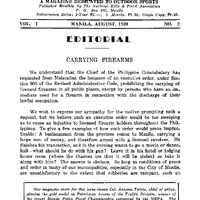 Editorial
Editorial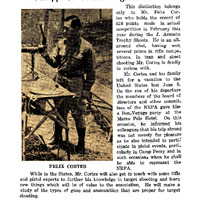 Philippines' Outstanding Pistolman
Philippines' Outstanding Pistolman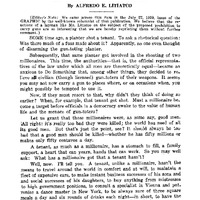 Little things
Little things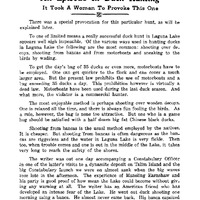 An Episode in duck hunting
An Episode in duck hunting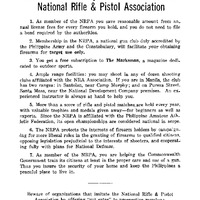 Seven reasons why you should join the National Rifle & Pistol Association
Seven reasons why you should join the National Rifle & Pistol Association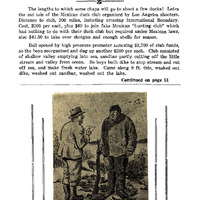 What price ducks
What price ducks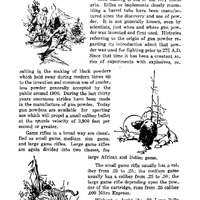 The Rifle
The Rifle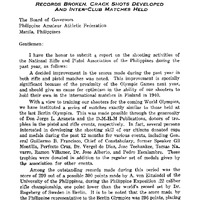 The Year in Review
The Year in Review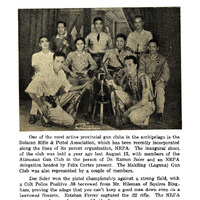 Bulacan shooters active
Bulacan shooters active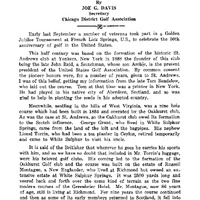 Early History of Golf
Early History of Golf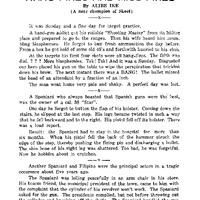 Hang fires and Miss fires
Hang fires and Miss fires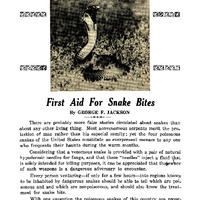 First aid for snake bites
First aid for snake bites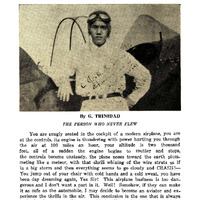 Here's to flying
Here's to flying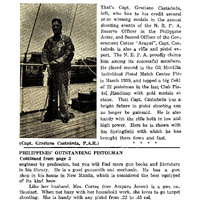 The Shooting Marine in action
The Shooting Marine in action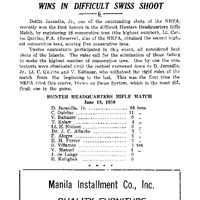 Jaranilla, Jr. Wins in difficult Swiss shoot
Jaranilla, Jr. Wins in difficult Swiss shoot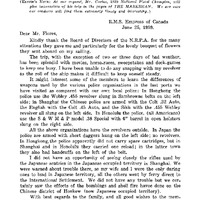 A Line from Cortes
A Line from Cortes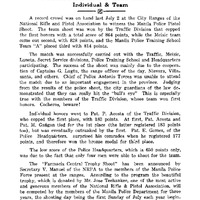 Manila Police Pistol shoots
Manila Police Pistol shoots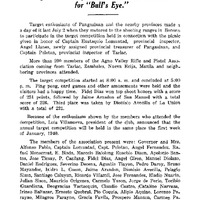 Pangasinan sharpshooters trek to Bonoan...
Pangasinan sharpshooters trek to Bonoan...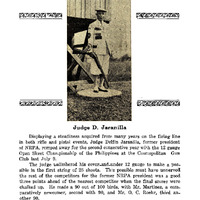 Judge D. Jaranilla
Judge D. Jaranilla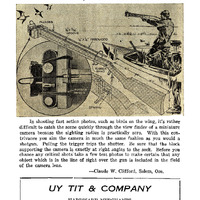 Camera gun helps take fast action shots
Camera gun helps take fast action shots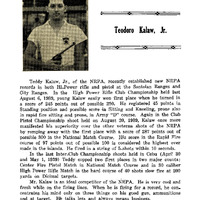 Teodoro Kalaw, Jr.
Teodoro Kalaw, Jr.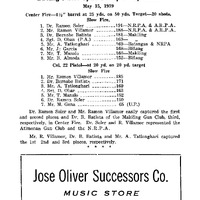 Biñang Pistol Open Championship Shoot
Biñang Pistol Open Championship Shoot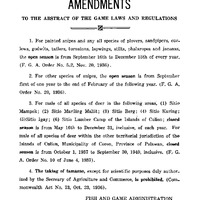 Amendments
Amendments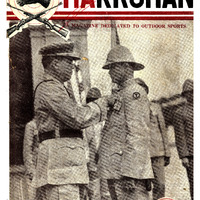 The Marksman Magazine Vol. I, No.2 (August 1939)
The Marksman Magazine Vol. I, No.2 (August 1939)